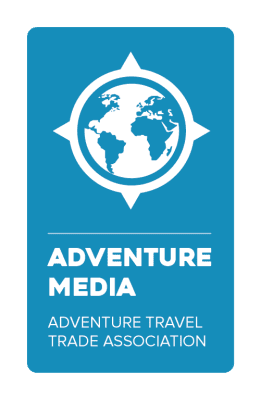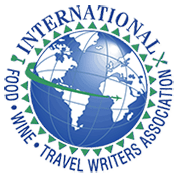Is Glamping the New Wave of Ecotourism – Our Experience at Elephant Hills Thailand
The more we travel, the more we see the importance of Ecotourism. This is a term that you hear often but what exactly does it mean? The International Ecotourism Society’s definition is “responsible travel to natural areas that conserves the environment, sustains the well-being of the local people and involves interpretation and education”.
These eight principles of ecotourism are how we choose to judge our glamping tour.
What is Glamping?
Glamping, or glamorous camping, seems like a natural way to travel to natural areas. Pitching a tent in the wilderness is the iconic image of returning to nature but can it be glamorous? Even more than glamorous, can it be green?
Glamping at Elephant Hills
We chose Elephant Hills, in Khao Sok Thailand because it is a highly regarded and award-winning ecotourism operator in Thailand. We knew that we wanted an ethical elephant encounter, a real jungle experience, and a kayak tour of Cheow Lan Lake. Their three-day, two-night Jungle Lake Safari offered all of these things and much, much more. We loved Elephant Hills so much that we paired them with a our favorite Thailand bike tour to make an epic 13-day adventure itinerary.
Ecotourism Principle: Minimize Impact
We found glamping greener than other options naturally. In the rainforest camp, our tent was set on a concrete pad with a metal roof overhead. It presented a very low footprint in nature. Plus, none of the surrounding vegetation had to be removed to build the structure.
The lake camp was built on floating docks and powered with solar and wind for an even smaller footprint. Plus, being in a tent, we didn’t need air conditioning.
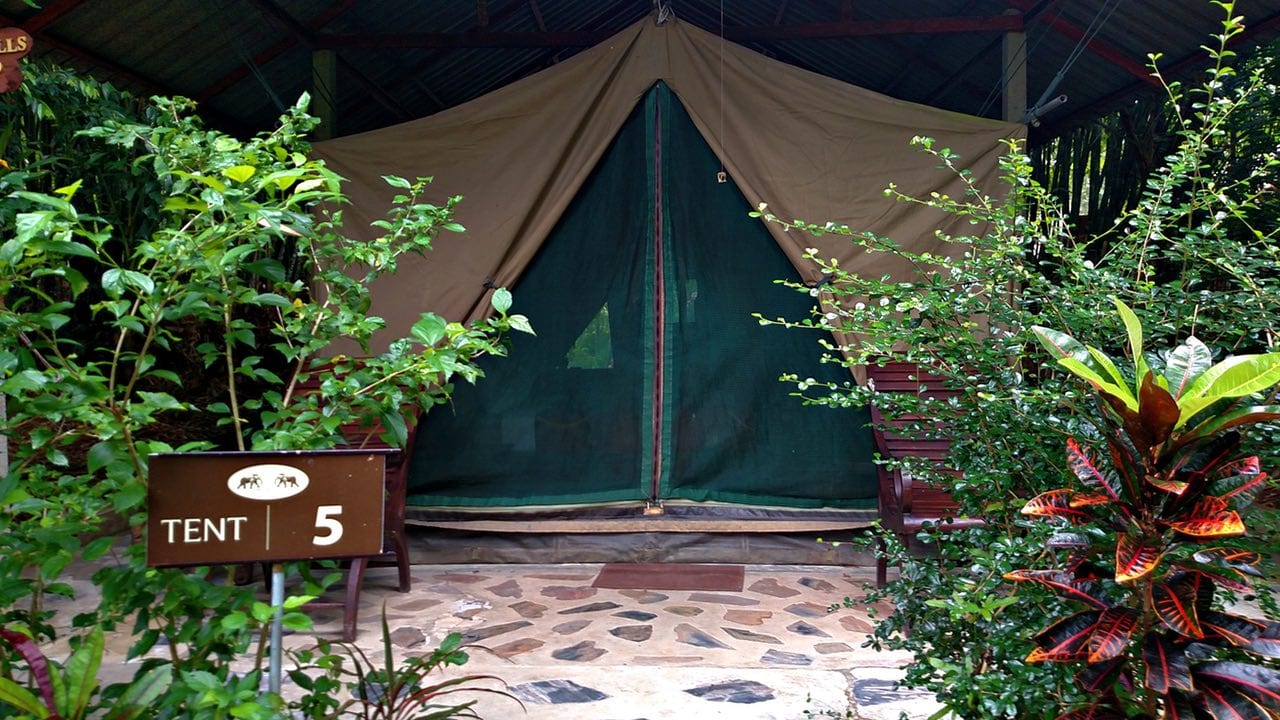
Now this is camping. Extra roof – check. Concrete pad- check. Comfy bed – check. Electricity – check. Indoor plumbing – check. I could get used to this.
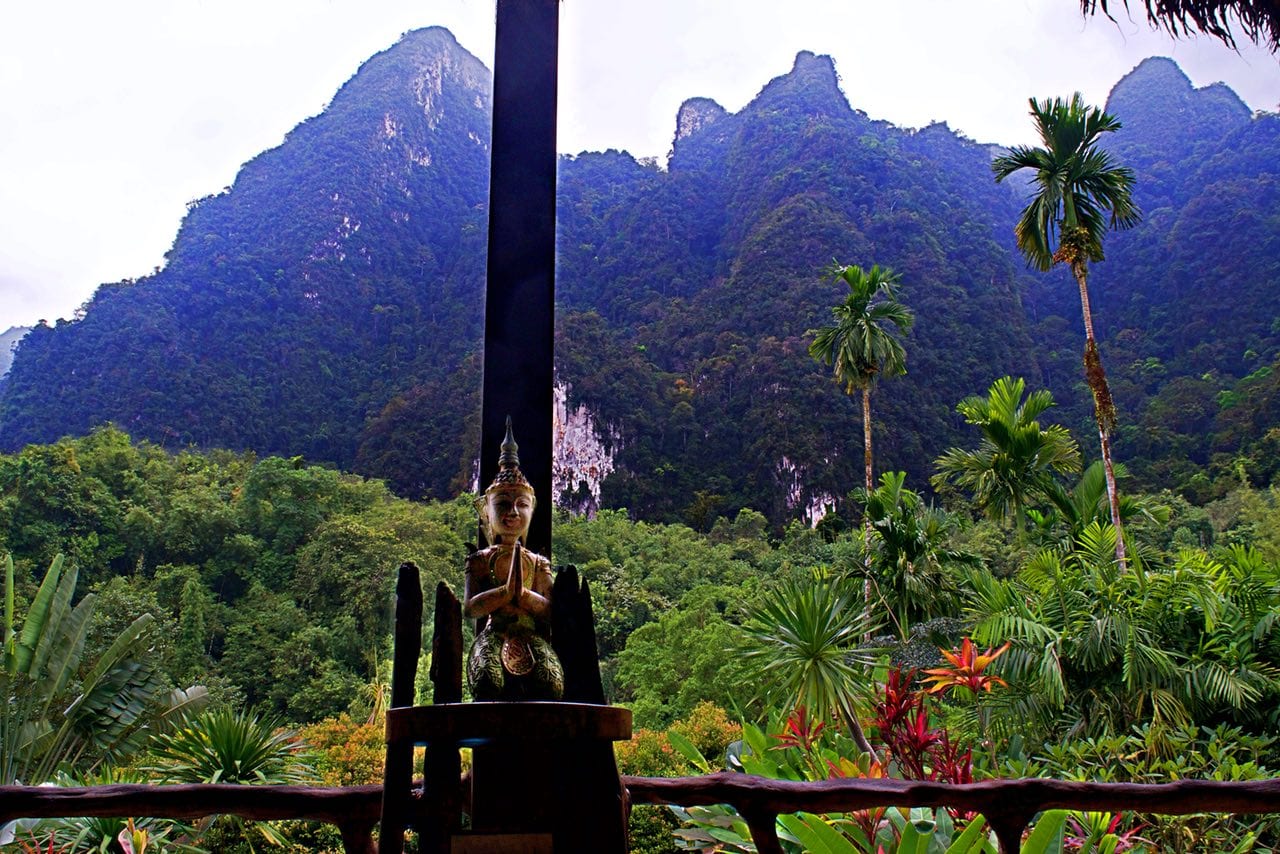
This was our view from the dining room. It’s like eating a gourmet meal in the rain forest.
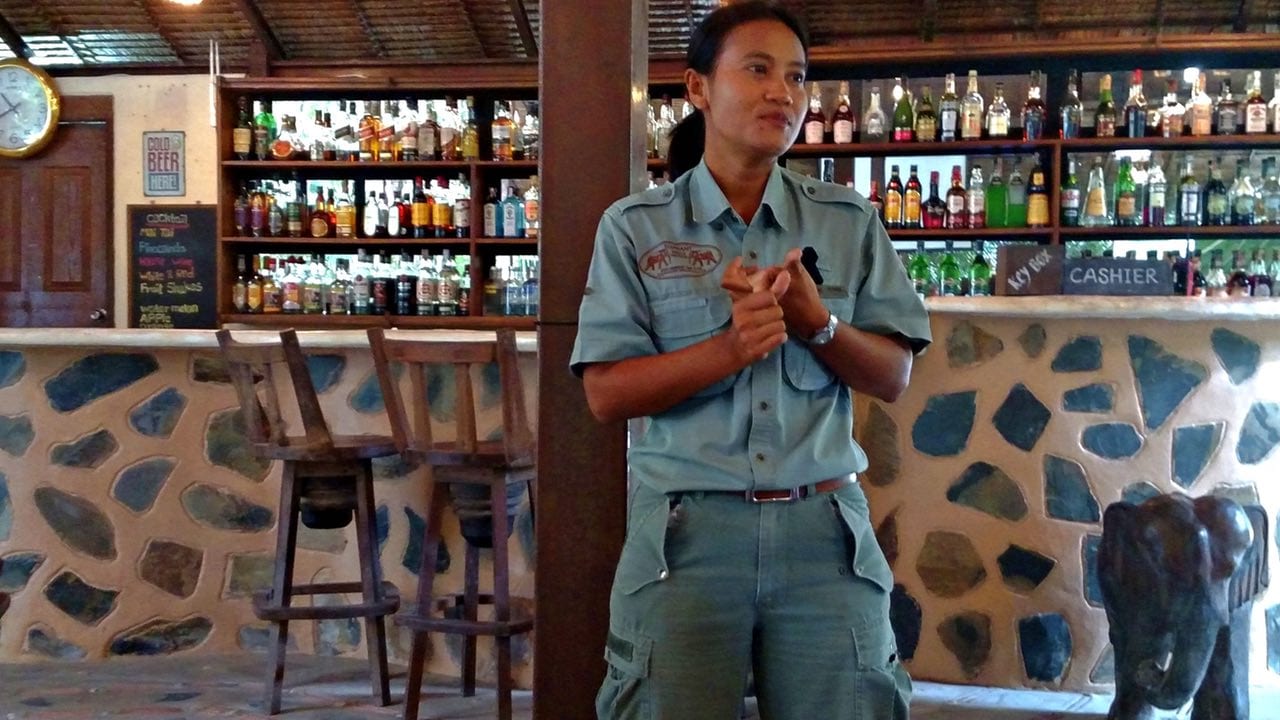
Kong was amazing. She knew so much about Khao Sok, Cheow Lan Lake and the beautiful elephants of Elephant Hills.
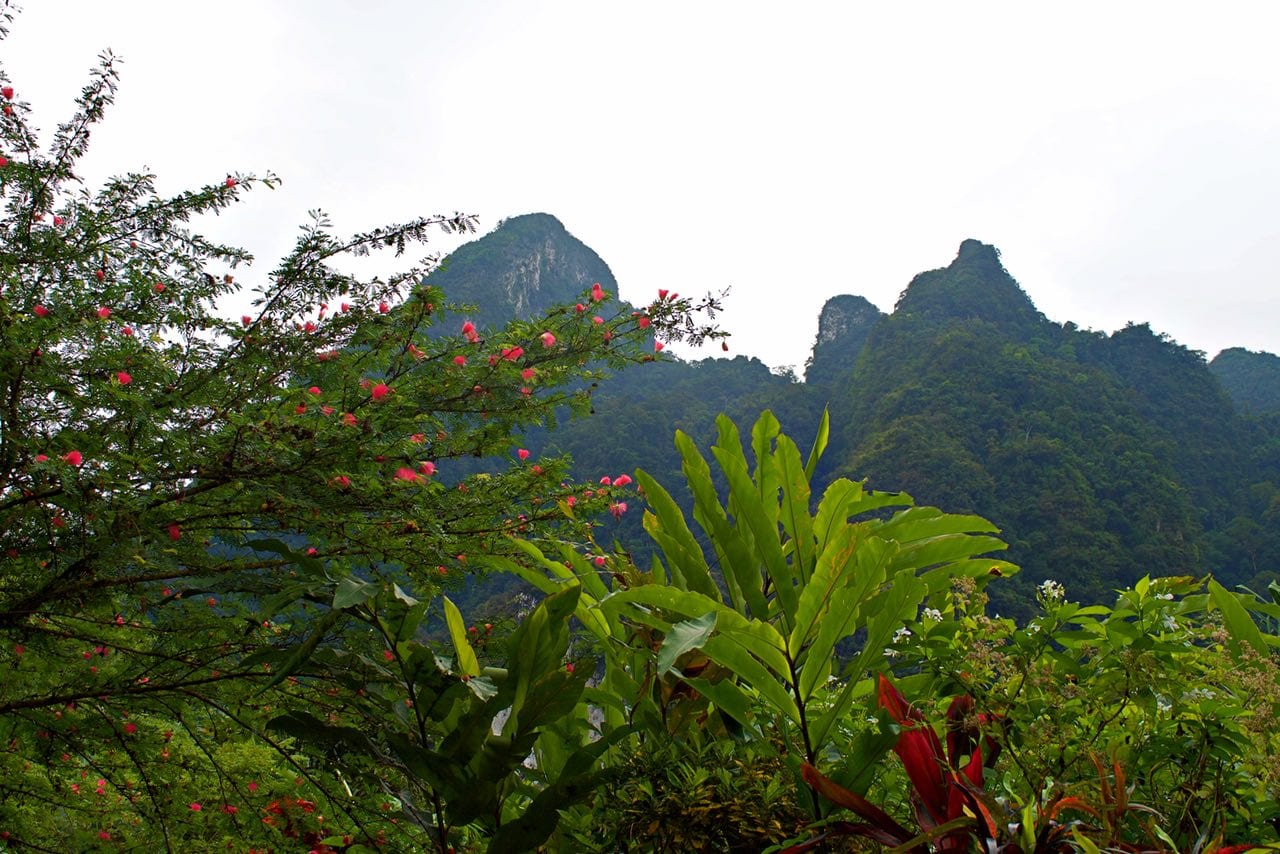
Being in an eco camp means that you stay further outside of town and get to see foggy mornings like this.
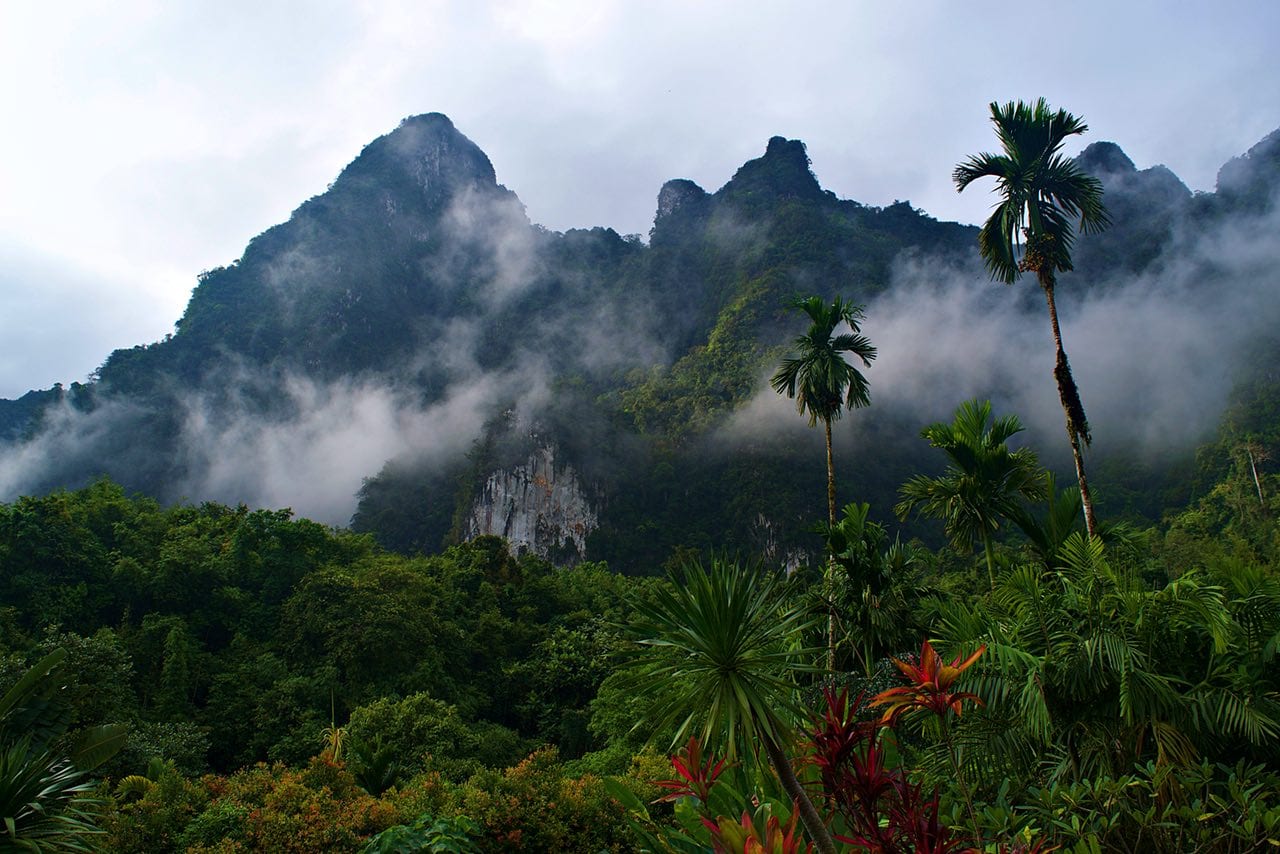
Elephant Hills Forest Camp was located in the rainforest against these dramatic karst cliffs. Glamping allows you to get right up to nature.

I don’t know why Tintin is in the foyer. There were a lot of non-Americans here so a European adventurer wasn’t a bad choice. Everybody seems to be posting their Tintin at Elephant Hills photo so this is ours.
Ecotourism Principle: Build Environmental Awareness
We were very excited to meet the elephants. Our bus pulled off an unmarked turnoff and soon we were in Elephant Camp. It wasn’t like any zoo we had ever been to. The enclosures were huge and the elephant was so far away it was tiny. We walked (and walked and walked) into what looked like a picnic area beside the enclosure. We realized the fences were keeping us in more than the elephants out. It was here that Kong (think Ricardo Montalban from Fantasy Island) began our elephant education.
The first thing everybody should be aware of is that there is no ethical way to ride elephants in Thailand. Indian elephants aren’t as large as their African counterparts so the average American is close to their weight limit and that doesn’t include any kind of a saddle. However, it’s much more than that. If you ever want to cry, google “Elephant Breaking”. It’s a physical and psychological conditioning program that is used to make elephants submit to being ridden, and it isn’t pretty. A small/slight mahout (elephant trainer) can ride their elephant based on years of trust and minimal equipment that no tourist will replicate.
Notice I said their elephant. Elephant Hills employs one mahout per elephant and they spend each day, every day with their elephant. They have a special rapport and know when she isn’t feeling well. This kind of relationship allows the elephants to feel safe and not need the abusive conditioning for human interaction. It also allows for immediate intervention if the elephant needs medical attention or needs to take a day off for their emotional state. Much like the minimal impact initiatives, I could spend this entire post talking about how well they treat their elephants. For brevity sake, let’s just leave it at these might be the happiest elephants in Thailand.
If we didn’t ride the elephants, what did we do? First we watched them jump in a small pond and take a bath. When they got tired of that, they climbed out and went over for a good washing. I think we got the dirtiest elephant of the bunch but we weren’t going to complain. It’s hard not to smile when you are cleaning elephants. After they were cleaned, we prepared an elephant lunch. There was a lot of chopping, then we could hand feed our new friends.
We felt like washing and feeding our elephant built a deeper connection than simply riding an elephant through the jungle. In a ride, you are bonding with the saddle. During our encounter, we could look these magnificent animals in their eyes and know we were making them happy.
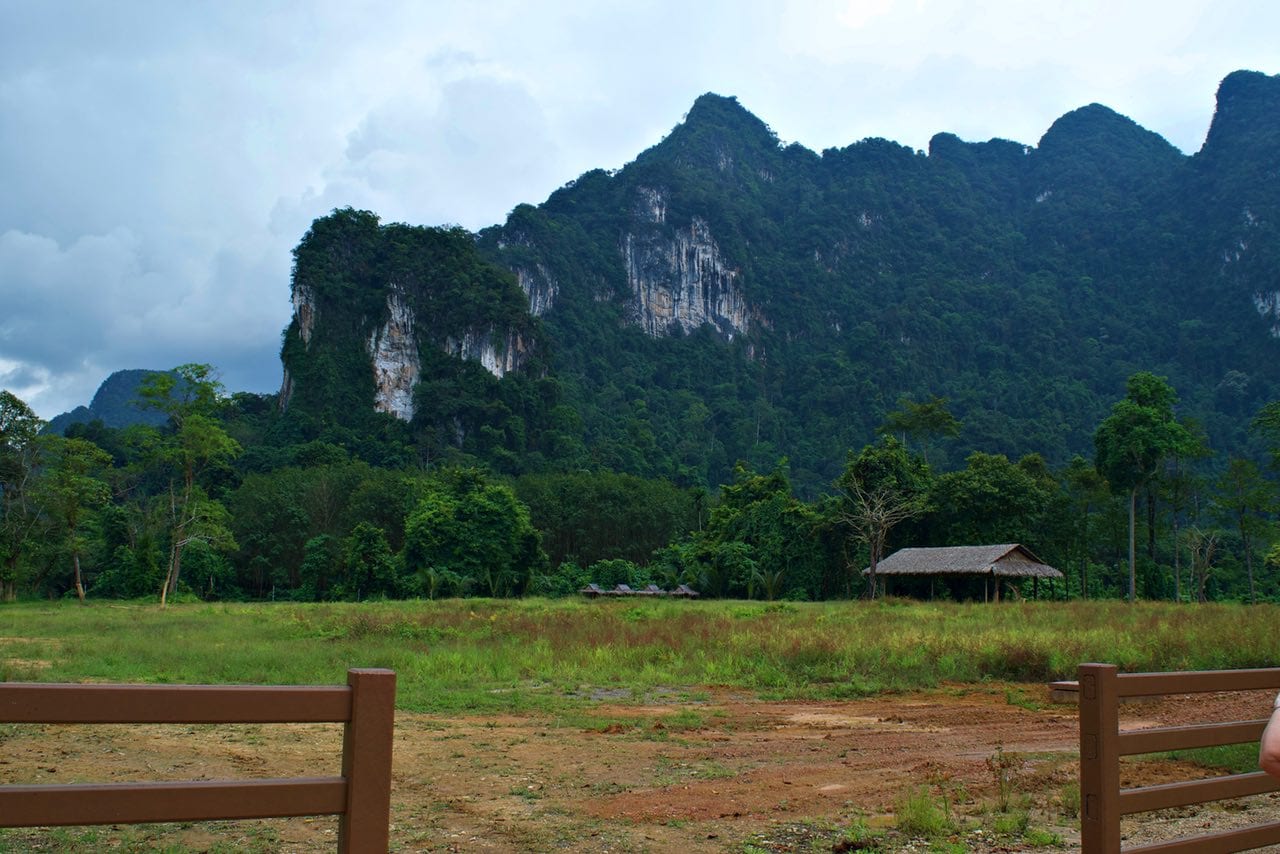
Somewhere in this picture is an elephant. She certainly has plenty of elbow room.
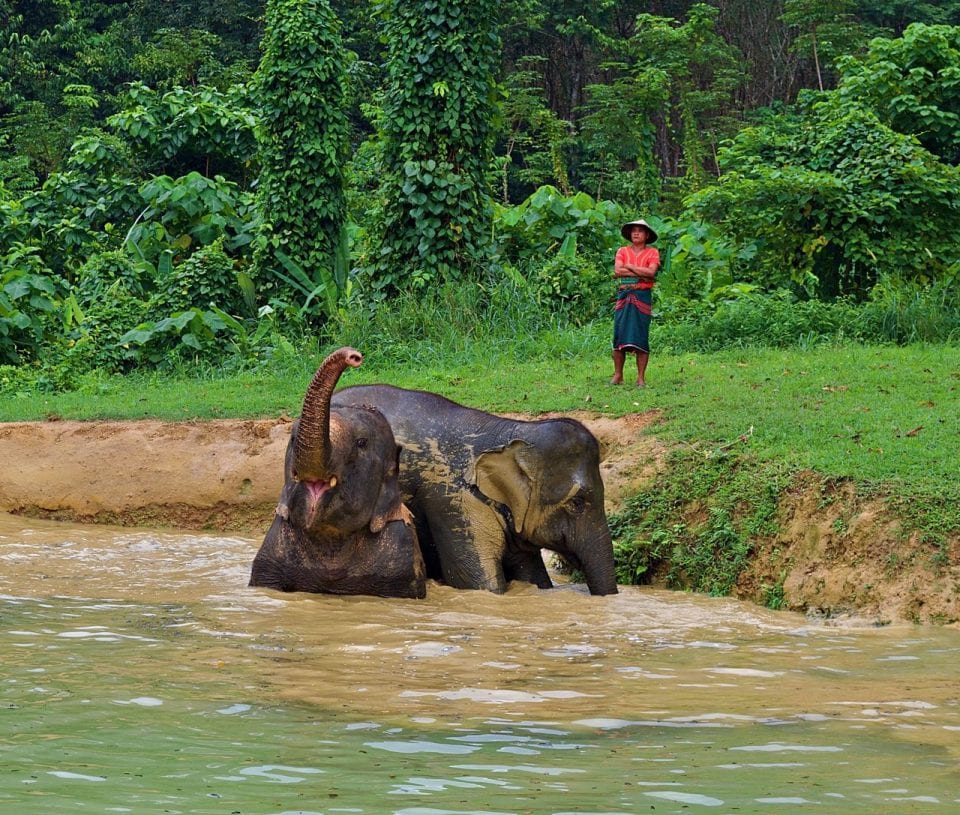
Before we washed our elephants, the mahouts made sure they were good and dirty. Doesn’t the little guy on the left look like she’s smiling?
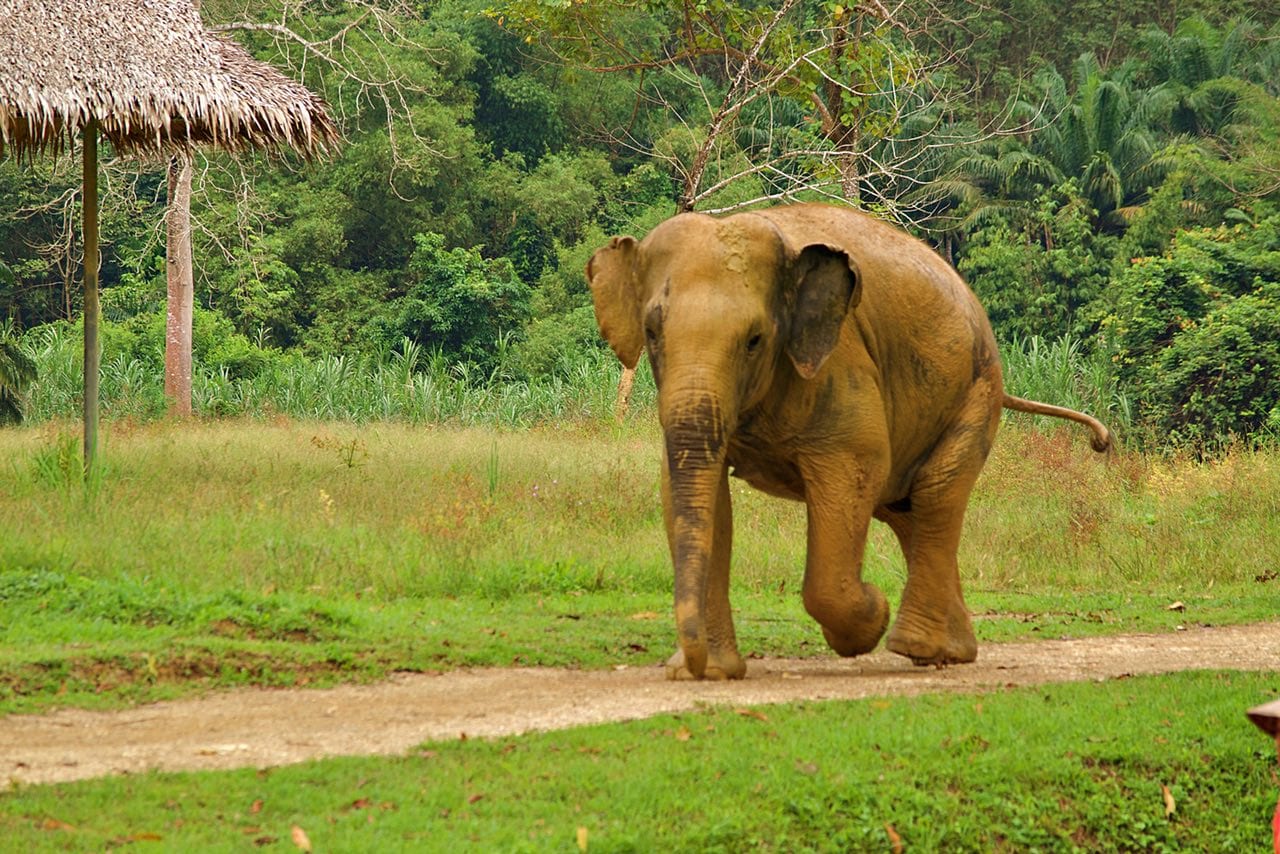
Here comes our dirty elephant for bath time. I think we had the dirtiest one of the bunch. That just means we get to wash more.
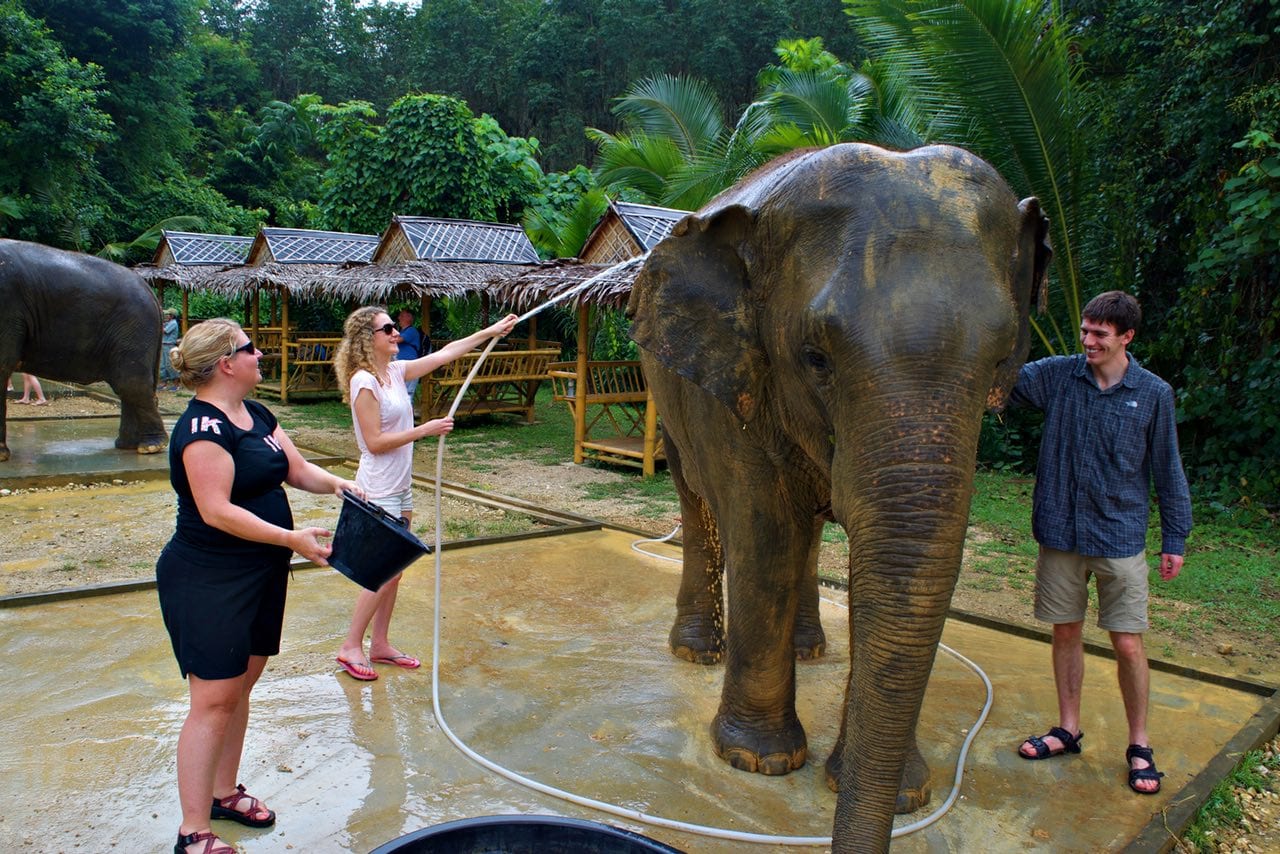
It takes a village to clean an elephant (or something like that). Matilda and Alex helped us out. Alex is not the smiliest of chaps, quite serious and driven, but look at that smile on his face. Joyous work indeed.
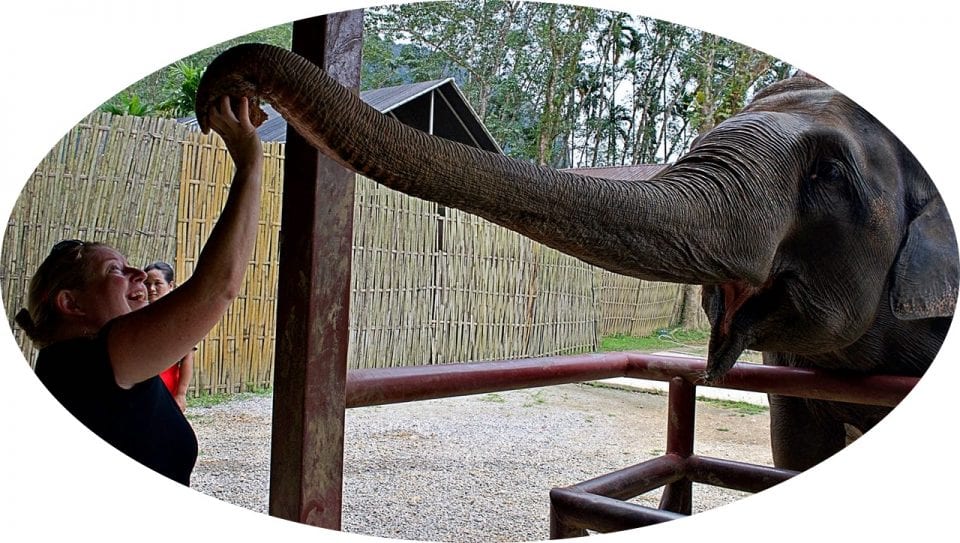
The next step in pampering elephants was snack time. We chopped up a bucket of fresh fruit and got to feed our beauties by hand. They knew the drill and were happy to play along.
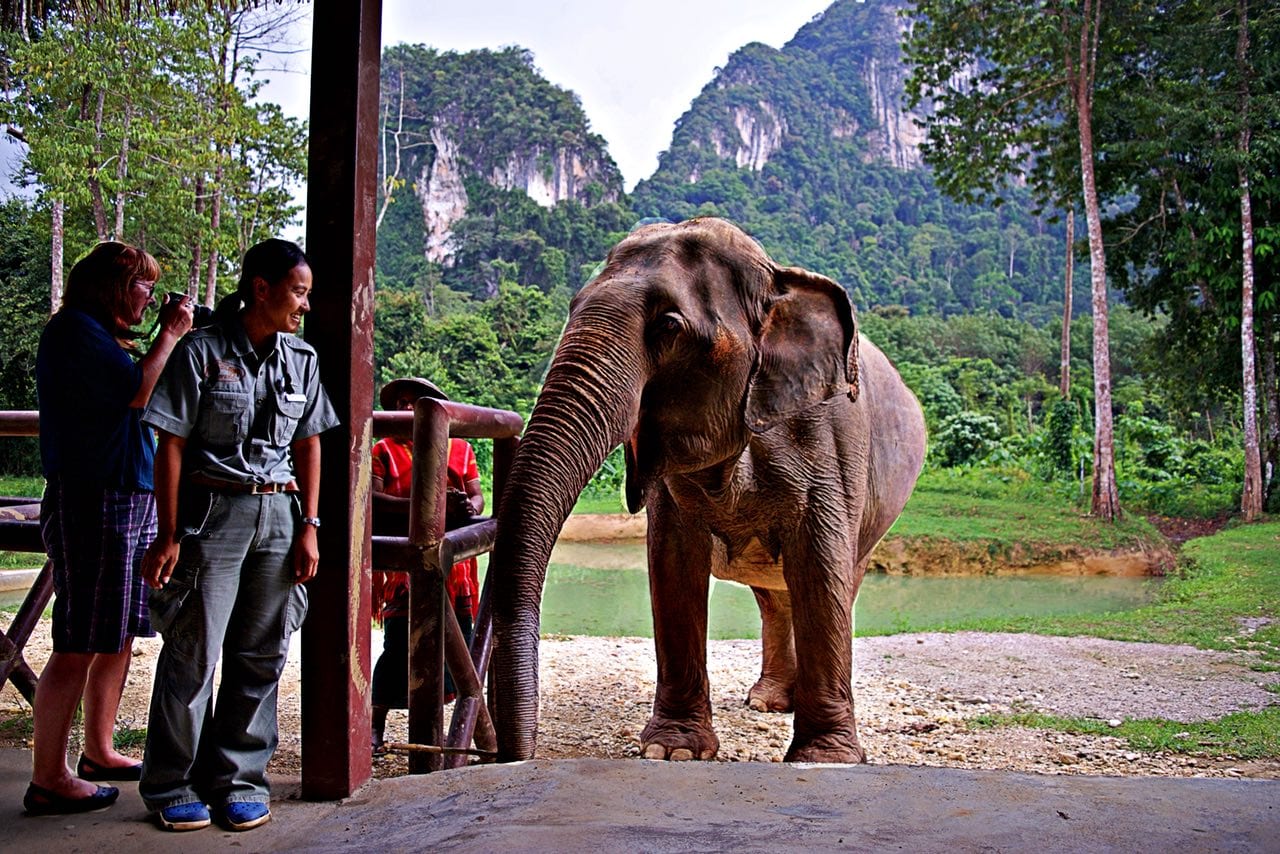
True to ecotourism education principles, Kong gave us a class in elephant 101.

These two girls loved each other. Elephant Hills only keeps female elephants because they are more docile and friendly. However, like any group of girls. They don’t all get along. There was one girl in the back who didn’t like these two.
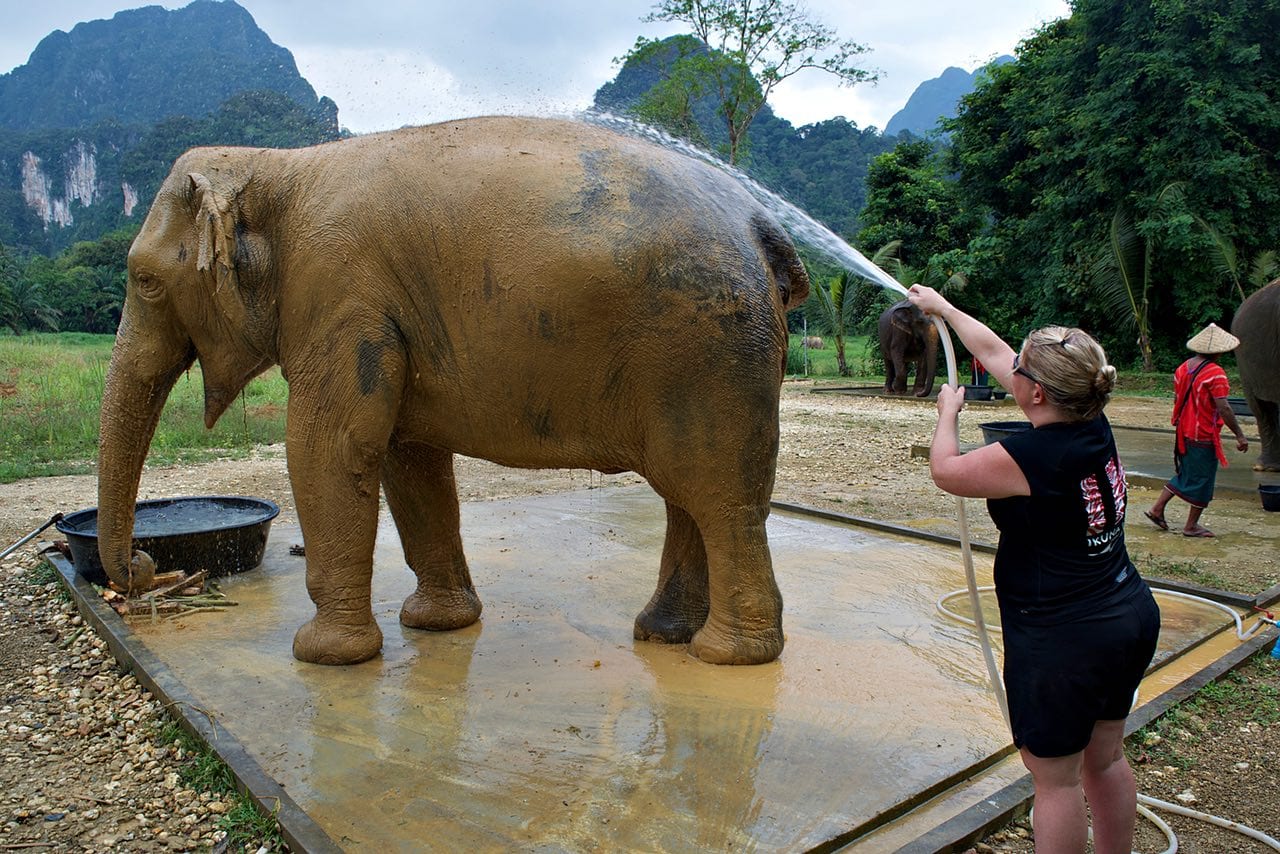
The first step in cleaning an elephant is good thorough hose down. I guess it might only wet the mud down a bit but it helps us bond before moving in with the hand tools.
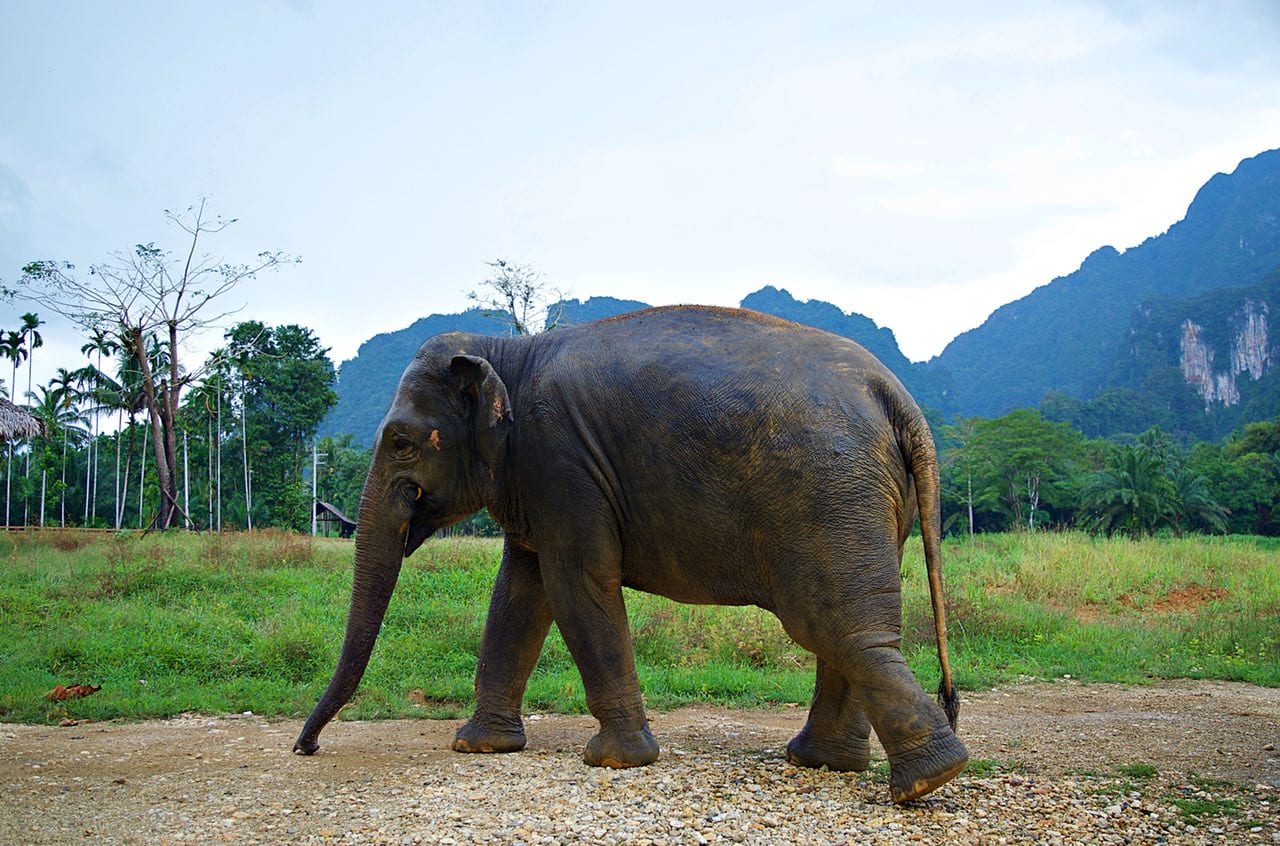
I’ll give us a b+ for cleaning. She’s looking better but I think we missed a couple spots on the back fender.
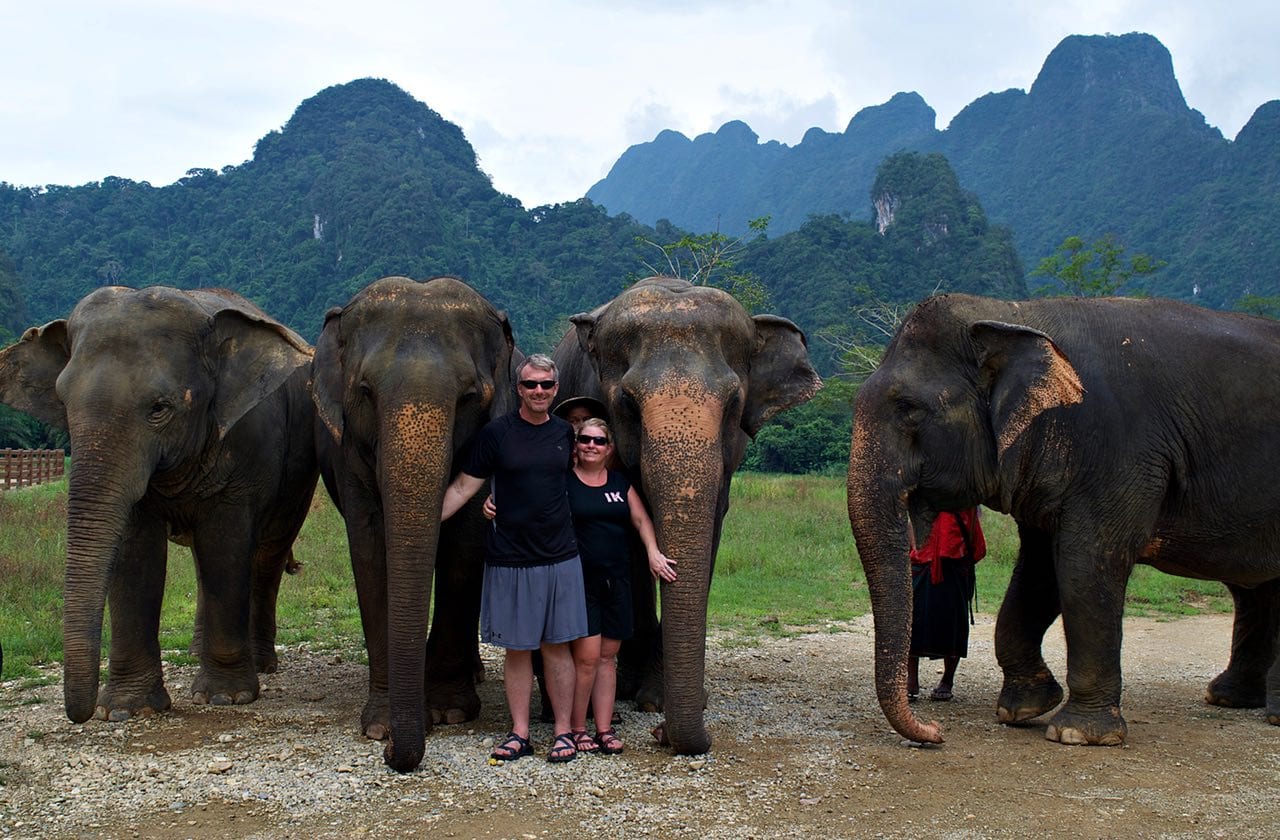
You know that one photo op that you have to take. You know everybody else has the same photo but you have to do it anyway. This is it. You, your love and a whole lot of elephant.
Ecotourism Principle: Provide direct financial benefits for conservation
Everything around the Elephant Camp was first class from the enclosures to the buildings where the vets would come to visit. This kind of facility isn’t cheap, and neither was our tour. I think it might even be an oxymoron to have a budget ethical animal encounter. Five-star service is a company philosophy and it extended to all levels of Elephant Hill’s operations.
We might be a bit salty from our gap year encounters on Koh Tao when we wrote this but it still rings true 18 months later as I am re-reading it. It’s one thing for a backpacker to choose to spend a gap year bouncing around hostels. It’s another thing to subject an animal to a lifetime of impoverishment and want. As ecotourists, you get to choose. It is important to learn the truths about traveling ethically before spending your tourist dollars. We posit that you’ll make a greater statement spending money to take ethical tours than whining about materialism and greed over pancakes and cheap beer.
Ecotourism Principle: Provide benefit for the community
The elephants and their mahouts were remnants of the region’s logging past. In the late 70’s, industrialists were getting ready for a large-scale logging effort. Before that could happen, the government made a forward-thinking decision to preserve this unique ecosystem by creating the Khao Sok National Forest. This was great for the trees, but mahouts were out of a job and an elephant has to eat. Luckily, places like Elephant Hills could provide quality employment for the men and a balanced diet for the beasts.
We met a second set of hill tribesmen that day who were also benefiting from our tour. They were our guides on a river run through the karst towers. I’m not going to lie. I was a little disappointed we weren’t going to paddle our own canoes. However, that changed one we got underway. Soon the guides were pointing out snakes and turtles we would have undoubtedly missed. They spun the boats at the exact time for us to see stunning views of the mountains behind us. They added another dimension to the paddle, a deeper and local knowledge where they showed us all the hidden gems.
Did I get my millennial buzzwords in? I should have because the guides added value and were extremely accommodating. Case and point – I dropped a cheap pair of sunglasses into the river. No big deal, they only cost a dollar and I had a spare at the hotel. Not for our guides. They dove in once, twice, three times and emerged with my glasses. Now that’s dedication to the cause.
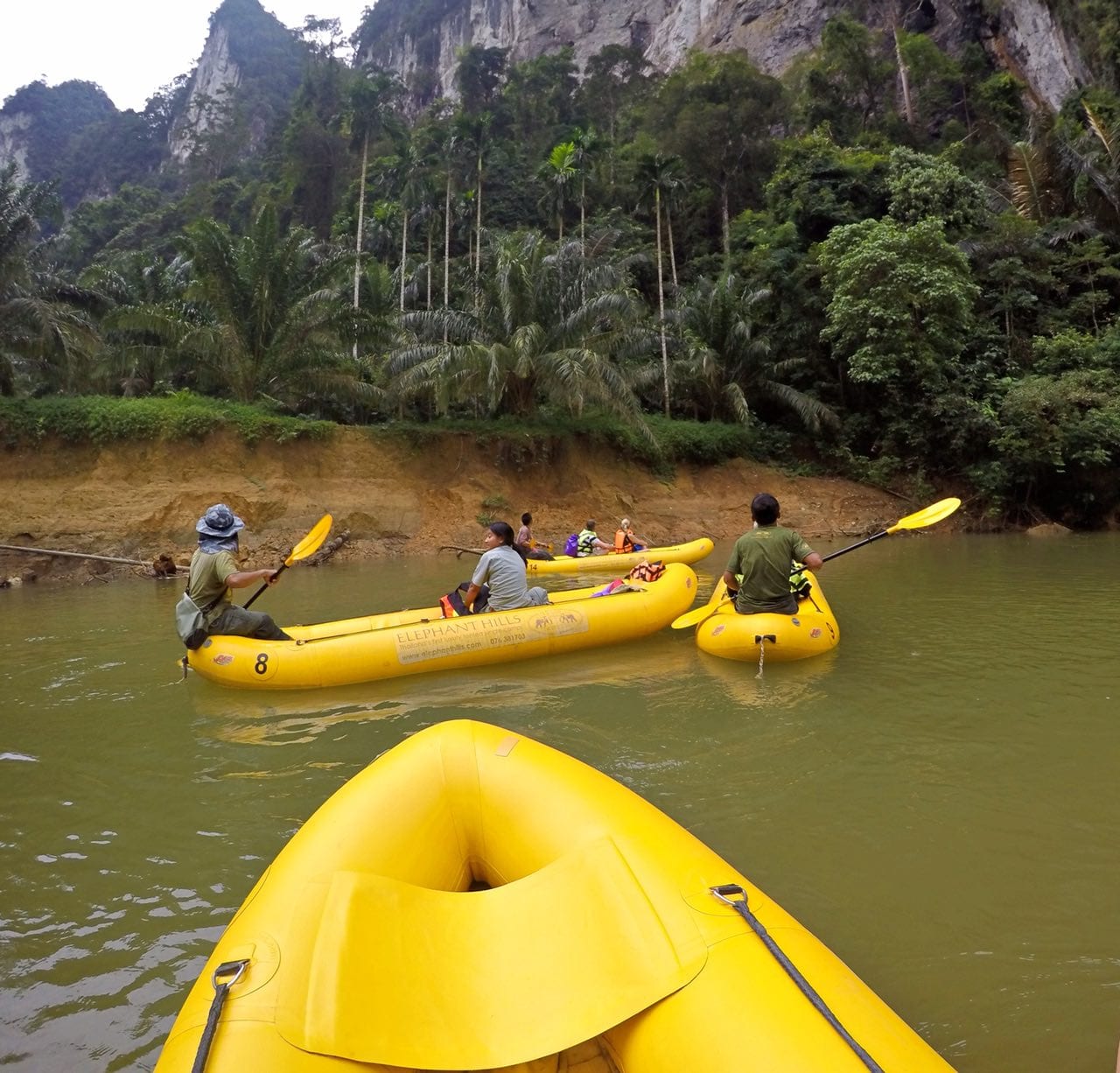
This is the way we kayaked down the river. One or two people in the kayak and the guide / wildlife spotter /engine sat all the way in back.
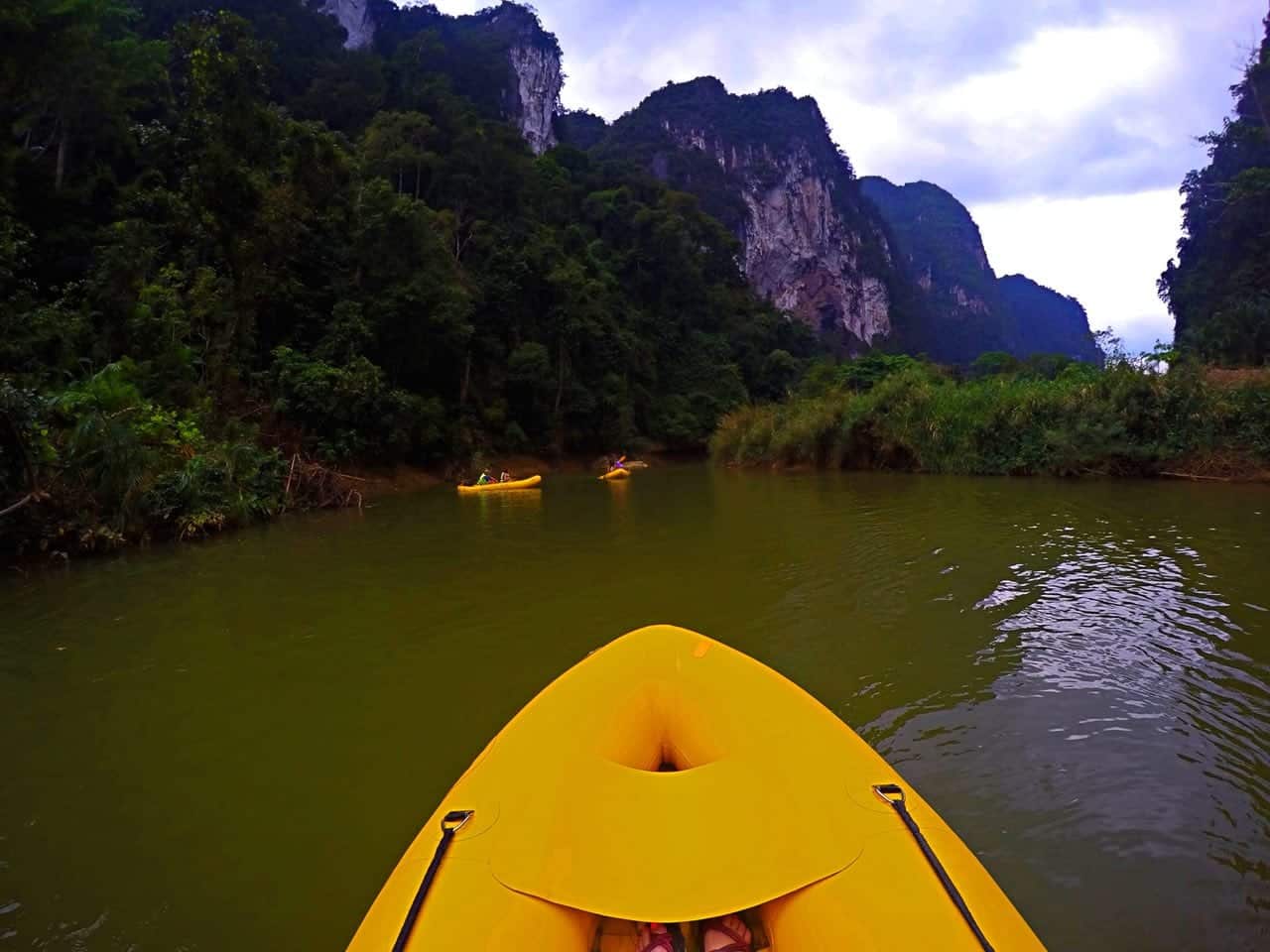
This is a fairly typical section of river. There were a couple of boats ahead of us. The water was flat with jungles and farms right up to the banks.
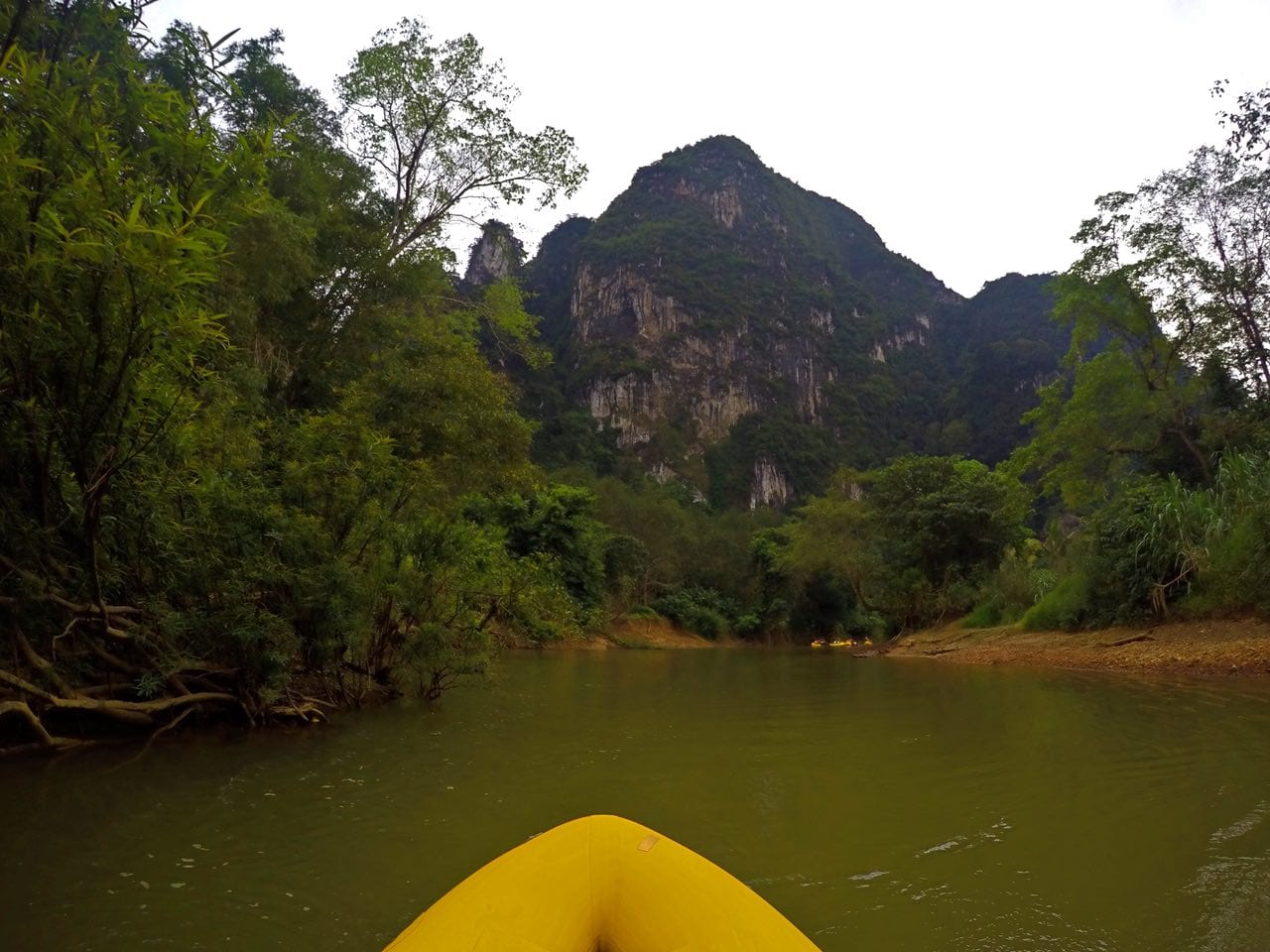
Around each bend there were new hills to look at. I imagine that hillside is full of caves waiting to be explored.

Towers that characterize tower karst can only develop in the tropics because it is only there that the right conditions of rock and climate – development requires a minimum of 120 cm of precipitation per year and an average temperature of 18 °C – interact to create these magnificent features.
Tower karst is a spectacular variety of kart landscape dominated by steep or vertical sided limestone towers. Towers originate as residual cones and are then steepened by water table undercutting from surround alluviated plains.
Ecotourism Principle: Provide Cultural awareness
Apart from the WOW! scenery on the river, we learned a lot about the area from our boat guides. We watched local kids spearfishing with homemade prongs and plastic masks. We floated by rubber plantations and asked what crops were planted in the fields by the river. We learned so much more from our guides that we would have gleamed on our own playing in the river.
The cultural education continued when we got back to camp. There was an afternoon cooking class available where people learned to make spicy green mango salad and, after dinner, kids came in from the local school to put on a traditional dance presentation. Dinner itself was glamourous and cultural. Every meal we ate with Elephant Hills was masterfully crafted from local ingredients to highlight Thai cuisine. It wasn’t just one dish either. There was a choice of appetizers, mains, desserts and even drinks that were all prepared with the same skill and attention.
After a day of washing elephants, running rivers and gorging on amazing food we were ready for bed. Before we retired, we popped online to post elephant photos. We were surprised that our tent in the jungle had the fastest wifi yet in Thailand. We were more surprised that it was the most comfortable bed in Thailand (even above the Conrad Bangkok). Glamping at it’s finest! As for mosquitos, the well-crafted tent with its built-in mesh did a better job at keeping bugs out than our treehouse lodges Khao Sok. There was no need for a mosquito net at night. Who says camping can’t be glamorous?
The next morning (after another fabulous breakfast) we headed out to Chow Lan Lake, but not before stopping by the local market to see a slice of local life. We tasted fresh fruit and specialty treats as we strolled through the stalls. Our guide Kong was there to answer all our questions and explain the barrage of sights, sounds and smells we were experiencing.
Kong also stopped at a lookout high above Ratchaprapha Dam to explain the history of Chow Lan Lake. The lake and Khao Sok National Park are very much related. First rugged isolation and then a band of student rebels (more of this story here) kept logging from decimating the forests. The Electricity Generating Authority of Thailand (EGAT), created the lake in 1982 to supply hydroelectric power.
The lake took five years to fill and displaced five villages and many animals. The ecology was protected by creating and protecting Khao Sok National Park along with the building of the dam. The displaced villagers; they are given exclusive rights to operate tours on the lake.
The tours on the lake were special too. Hiking through jungles is hard, but you don’t have to do that at Chow Lan Lake. You can ride in longtail boats through amazing karst formations and next to dense jungles. Previously inaccessible landscapes are opened up to you. We took about an hour detour to explore these sights on the way to Lake Camp.
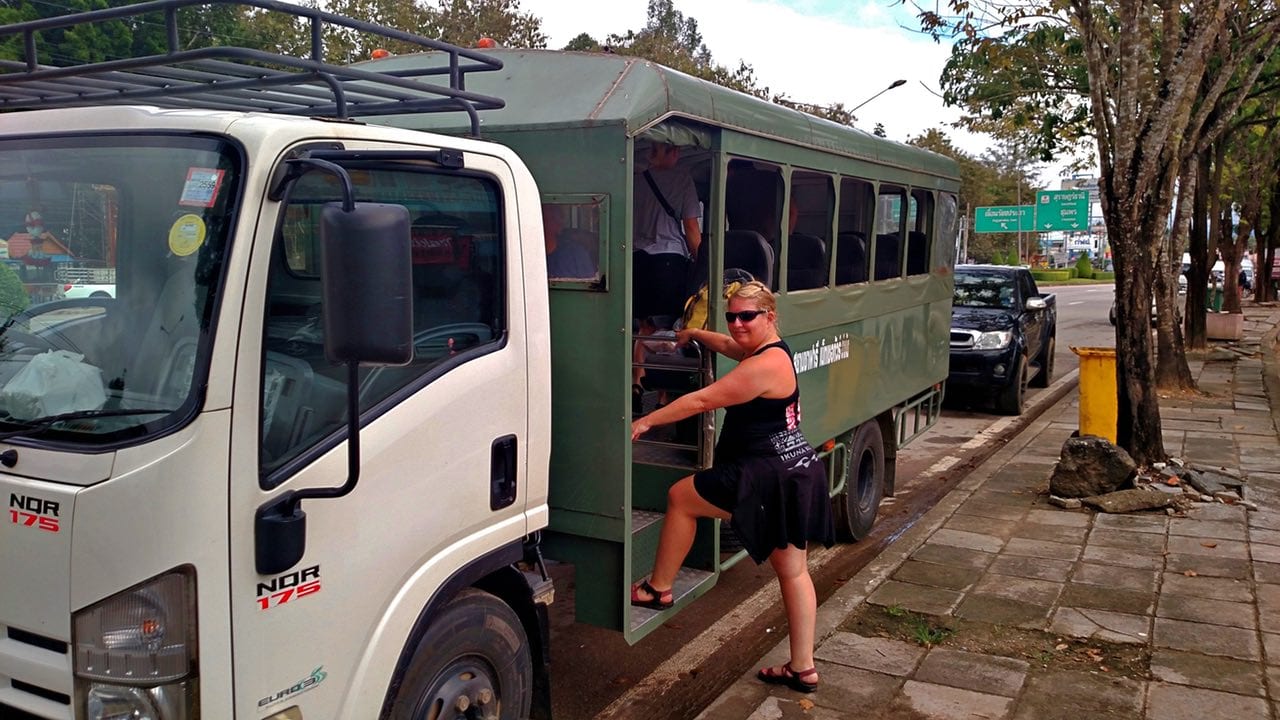
Even the buses felt like adventure. Doesn’t this look like something we should be storming the beach in? Thanks to the lovely Jenn for posing.
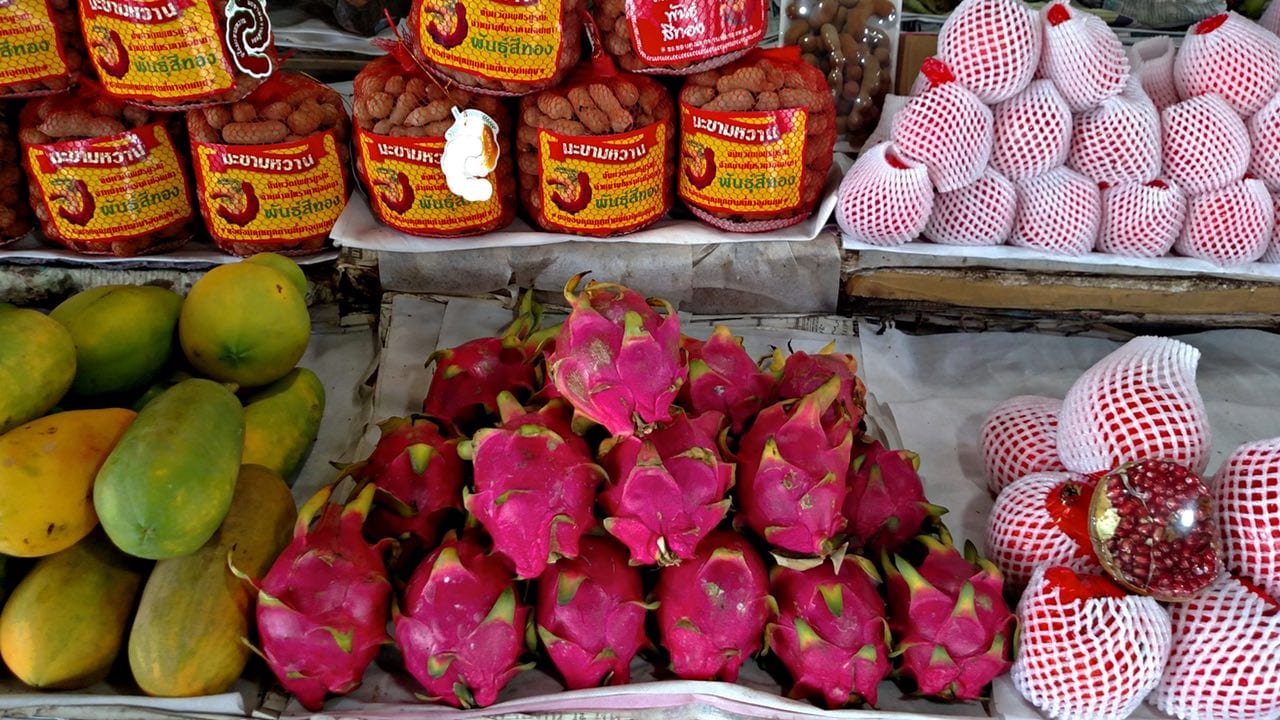
Have you ever tried dragon fruit? It tastes a little like melon. Every morning for breakfast at Elephant Hills there was some dragon fruit available.
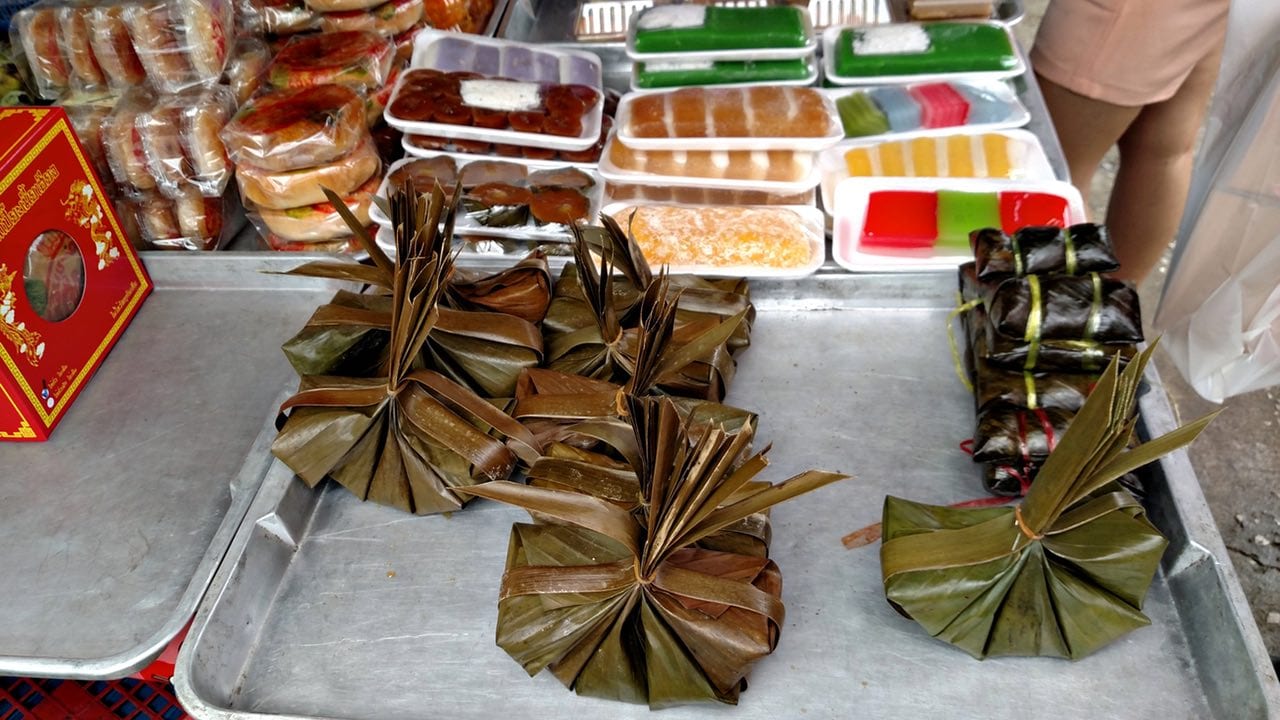
Hmm sticky rice and candies. I could go for some mango sticky rice right now. Nothing says Thailand like sticky rice.
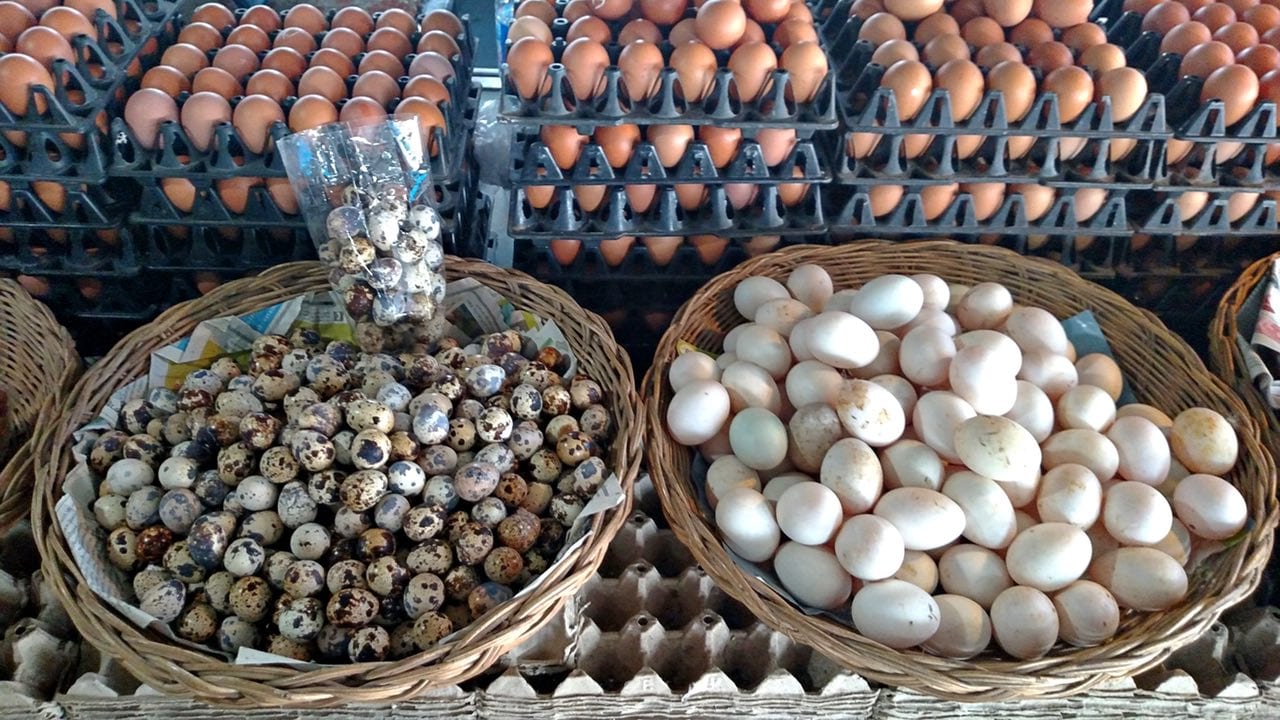
You can’t always find egg-sactly what you are looking for at the market. They had little eggs, brown eggs, and even fermented almost hatched eggs. I love making tiny little fried egg platter with the quail eggs.
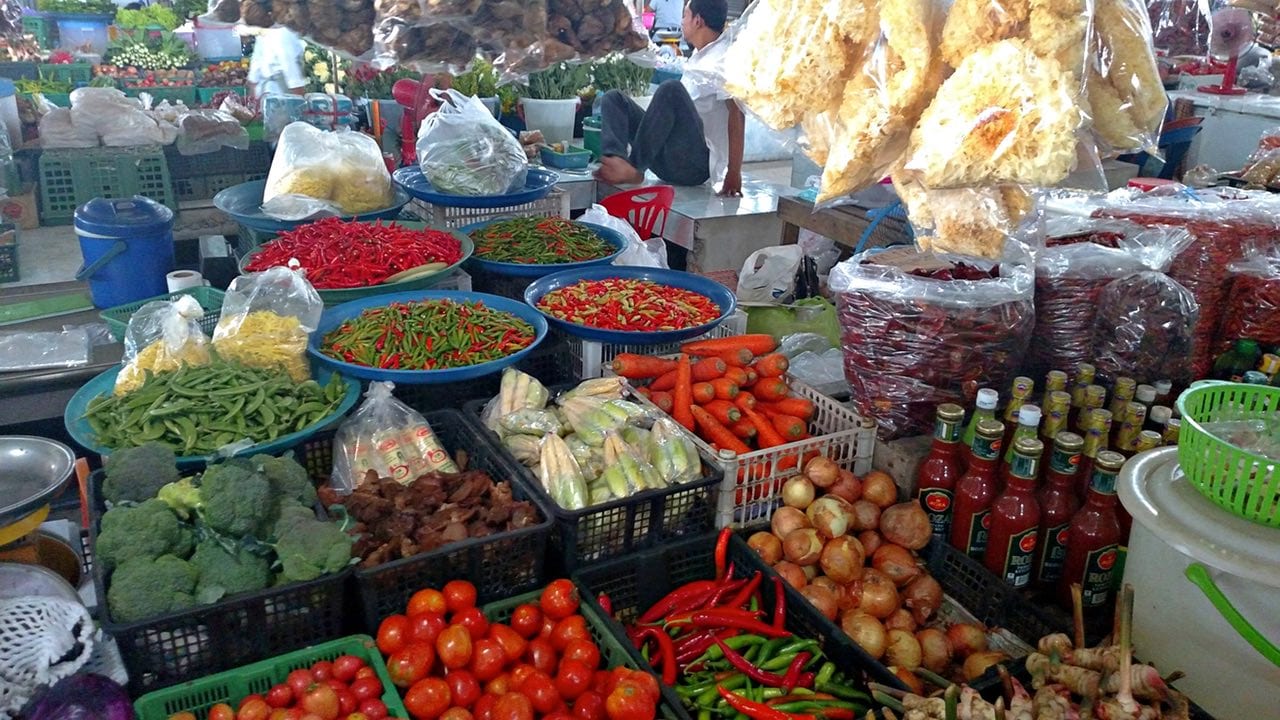
Look at all these amazing vegetables! The broccoli looks bright and green and I am missing those hot chili peppers already. What a wonderful way to get your groceries.
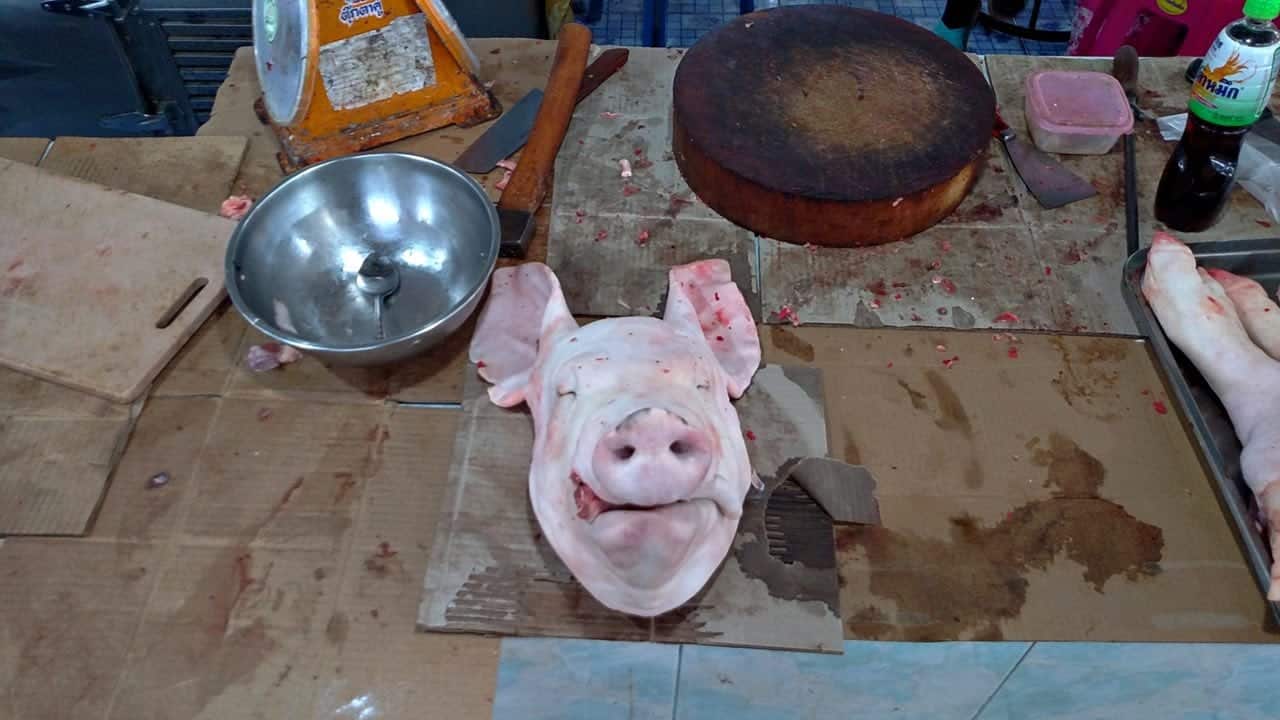
I can’t tell you how many times I went to the grocery store in San Diego and couldn’t find whole pig heads. Actually I can. Never. I can’t think of a single recipe for whole pig head.
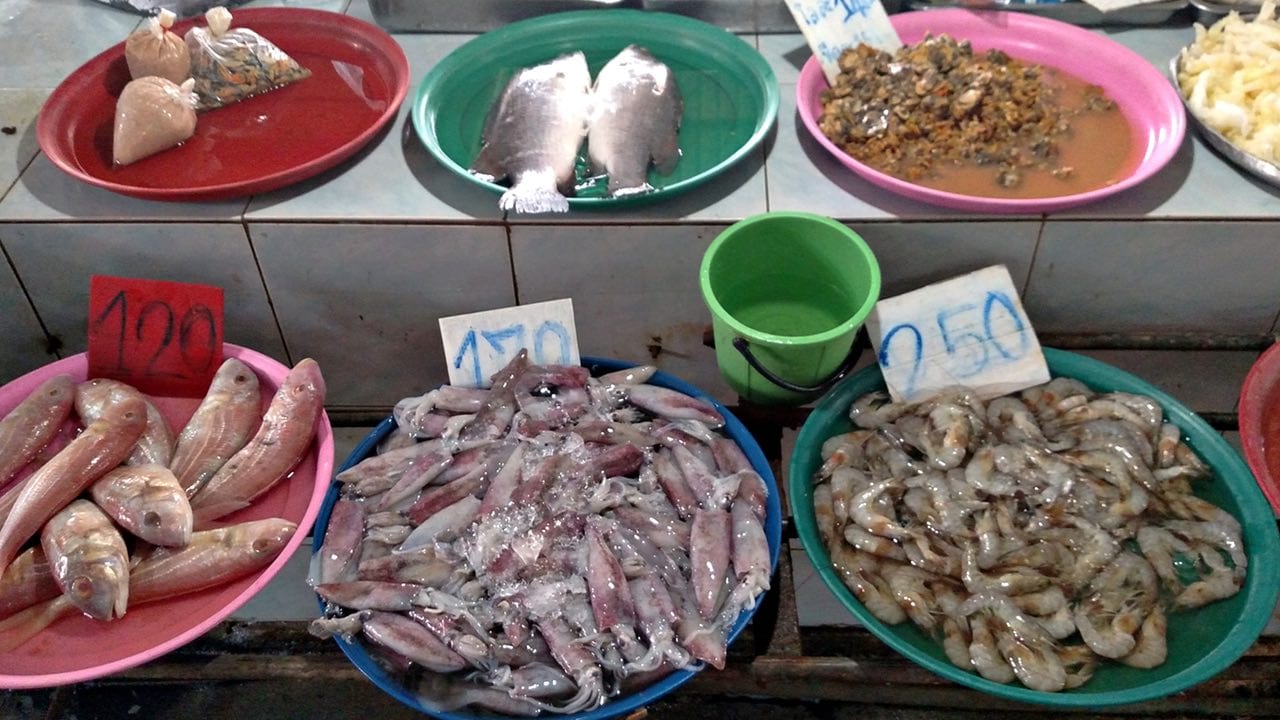
Jenn thought this was just as scary as pig head but I disagree. The fresh fish in Thailand was super yummy. Interesting enough, there was fresh water fish from Cheow Lan Lake at the market that usually isn’t found in Thailand.
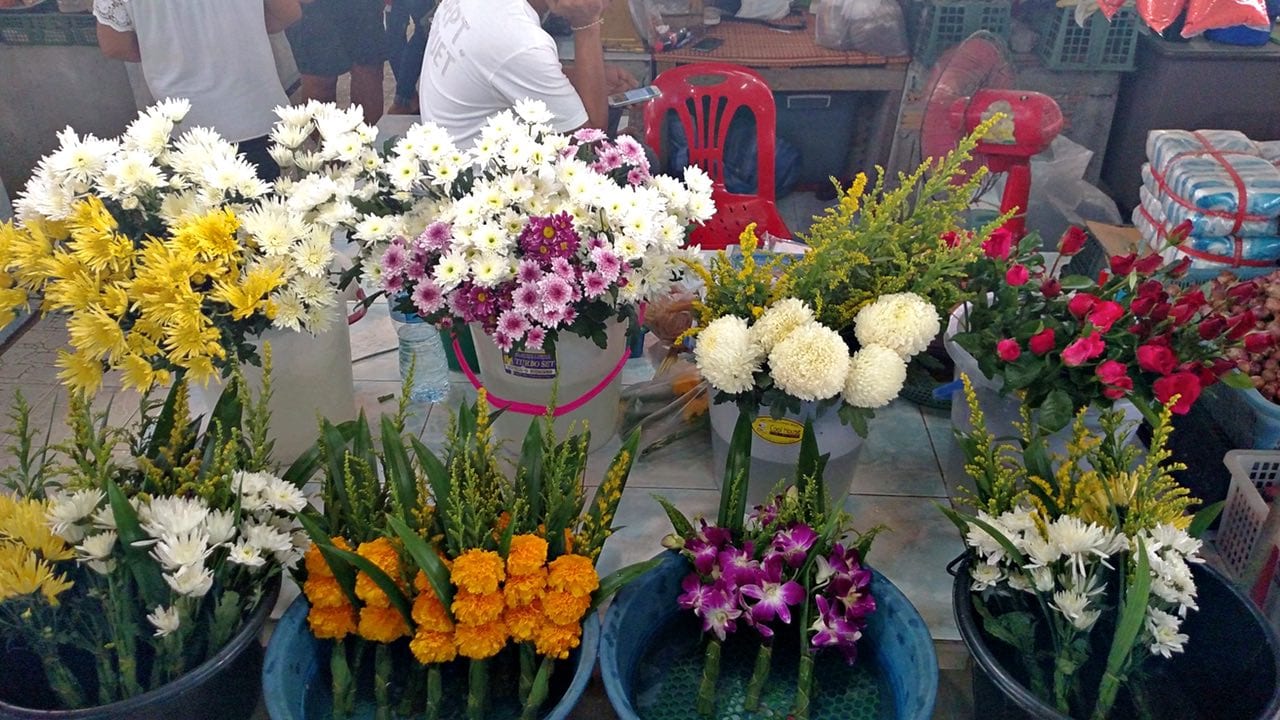
I don’t know if we just have a thing for tropical flowers but these look just like something we would buy at the florist back home.
Eco Glamping at Cheow Lan Lake
Our Lake Camp was just as plush and comfortable as the Jungle Camp. Every tent had a bed and even ¾ bathroom. The shower was heated by on-demand propane tanks. The electricity was gathered by rechargeable solar cells and the plumbing flowed out of sight under the floating walkways. Every tent came with its own kayak and you could jump in and swim right out of your front door. Somehow, the meals here were just as diverse, yummy and culturally relevant as the mainland resort.
We had a couple of hours to relax, play and eat lunch before the afternoon activities started. I choose to take a guided jungle trek up a steep trail. The local ranger pointed out spiders, shelf fungus, and exotic trees along the way. My favorite was the sandalwood. He passed around a piece of bark from a fallen branch for us to smell. It smelled like fine incense only fresher.
When we got to the cave, we placed a little offering at the spirit house for the cave spirits and entered the dark beyond. As far as caves go, I was a little disappointed but then again, I have been on real expedition caving before, pushing into the deep unknown where no man has ever walked.
The entry room for the Cheow Lan cave was neat. It was in a west facing bell dome collapse that got afternoon sun. Green algae covered enormous speleothems. We got to see the sunlight streaming in when we exited too.
We passed by a beautiful rimstone dam/calcite waterfall and into the dark zone. This was a huge, borehole passage with a dirt floor. There was more than ample room to walk around which made it easy to avoid the more than ample supply of crickets and spiders living here. We took the time to observe some particularly venomous spiders who made this cave their home. After about five minutes of walking, we reached the end of the line. The huge passage just ended so we turned around walked back out.
The descent down the steep, slippery trail was more fun than the lung busting climb. We actually took a different trail back and exited the forest in a little bay where our boats were waiting. The fading sunlight on the lake was nothing short of magical.

You can tell how deep the lake is by looking at the dam. It’s well over 100 meters deep in spots. I imagined diving down the submerged villages but I don’t think I could make it that deep.

There were other long tail boats out taking tours of the karst. Our boat looked almost exactly like this one.
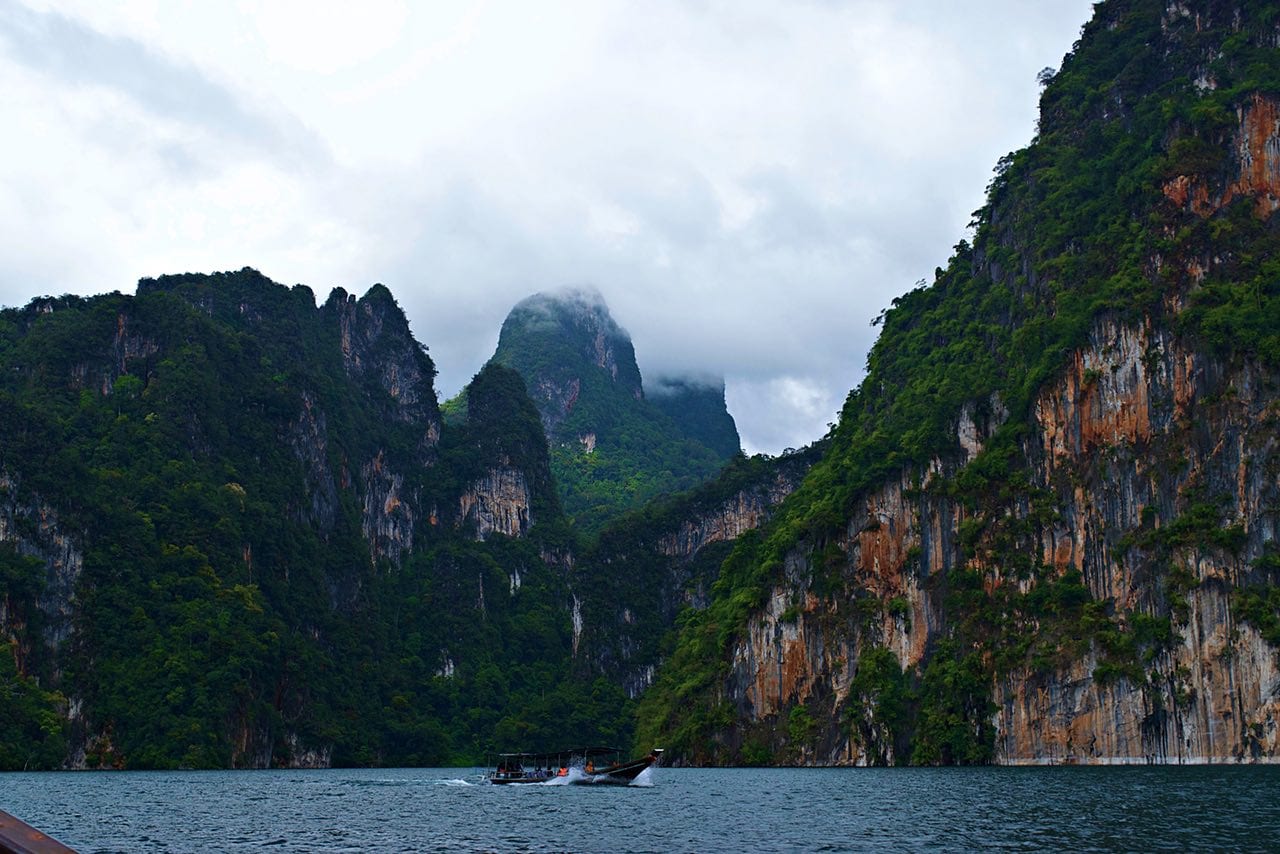
There was a lot of lake, we toured this small back bay. I don’t know how many other bays there were with their own unique view. This was the closest bay to the boat dock in the deepest section of the lake. I am not sure which aspect was drawing all the guides here.
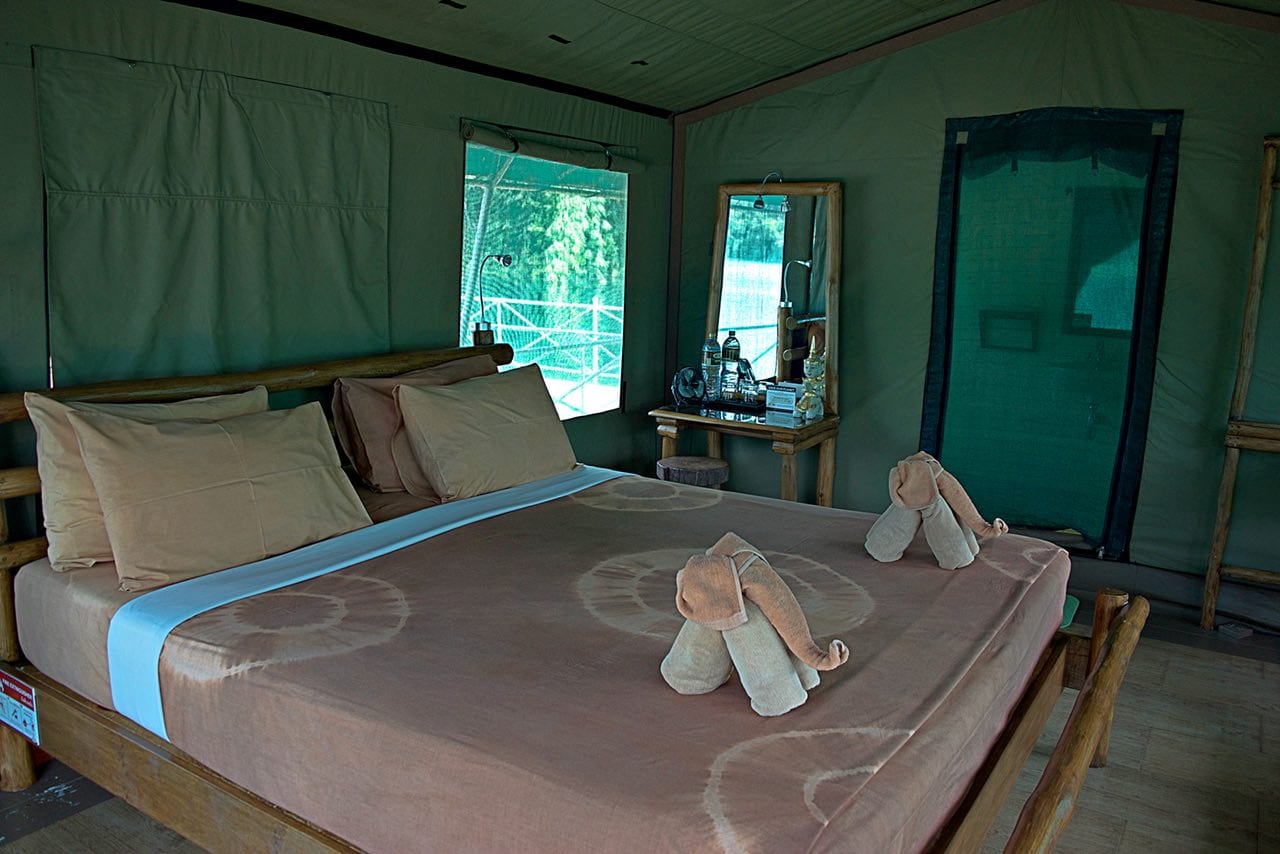
Everything you need to know about glamping is right here. Comfy bed – check. Special extras – check. Indoor plumbing (you can see the bathroom) – check. Even some kick ass mosquito nets, which weren’t really needed on the lake.
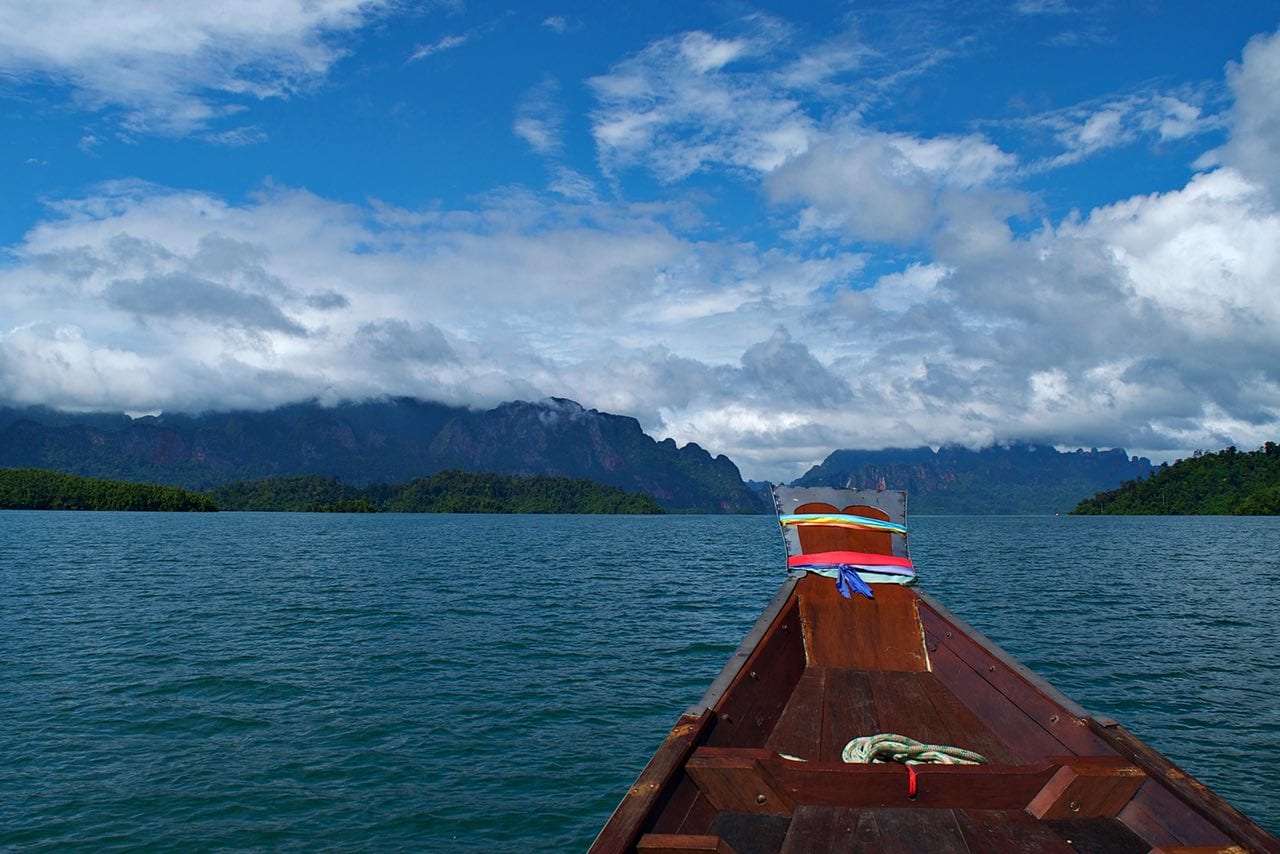
The ribbons on the bow are blessings from Buddhist monks. We bristled with excitement and anticipation as we crossed the lake. We were promised a lake tour and here it comes.
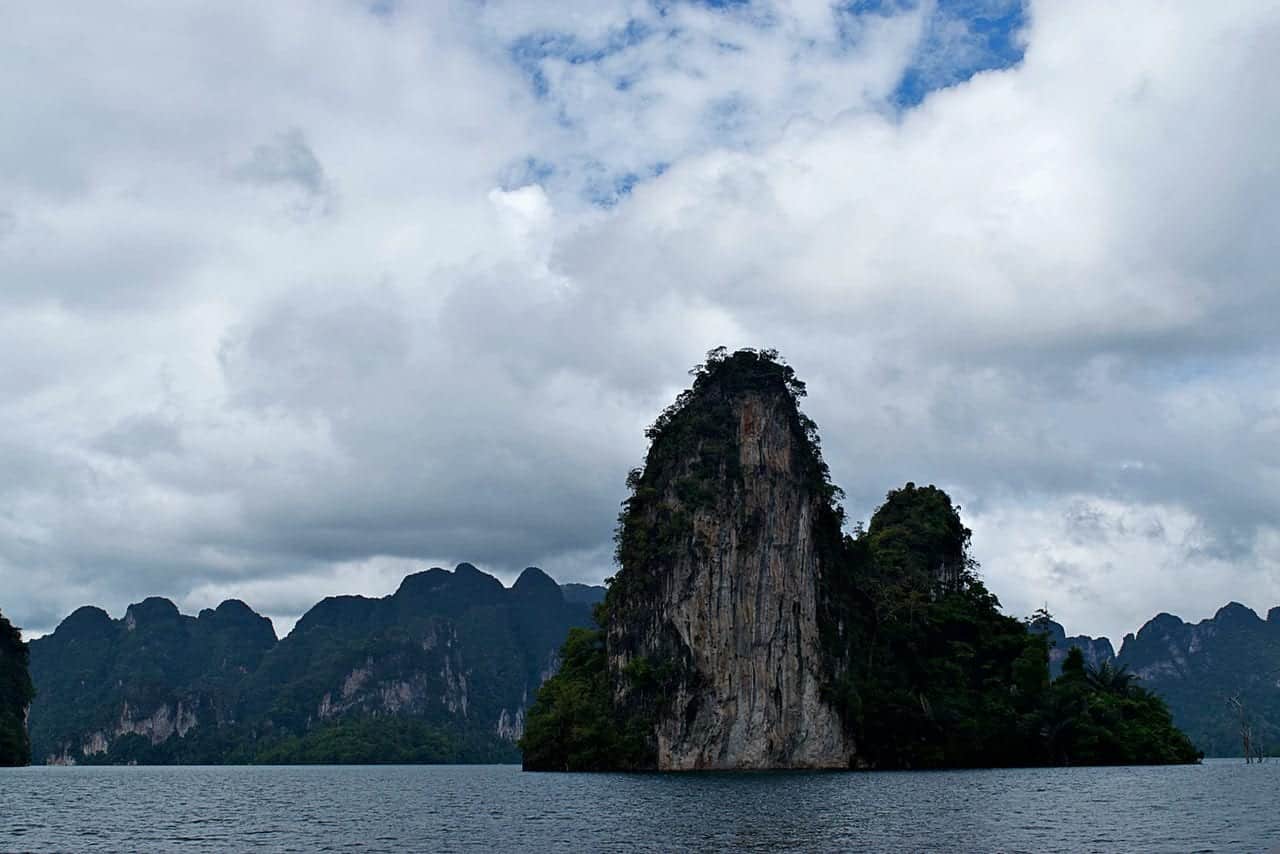
Thirty years ago this was a mountain. Now, it’s a island. This is another karst tower like we were seeing from the river, with a lot higher water.
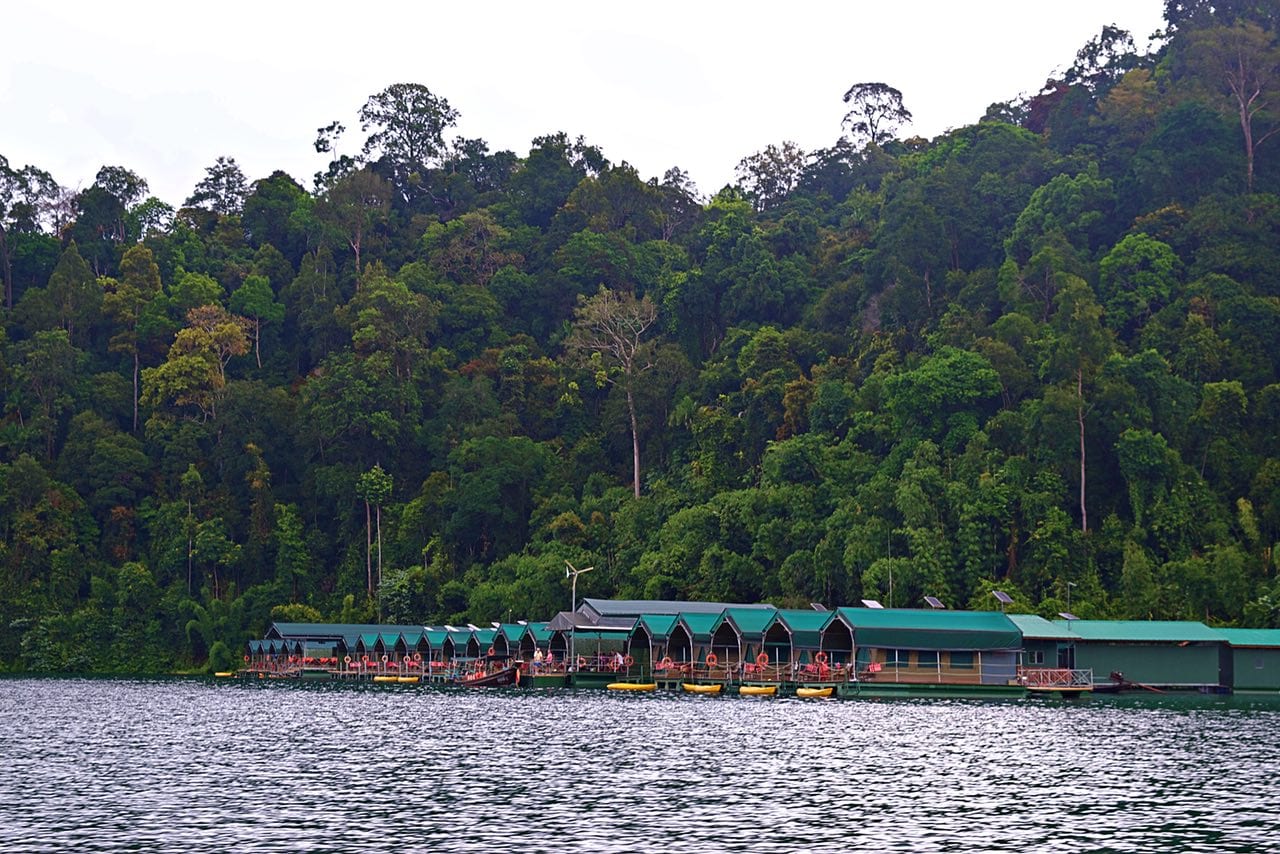
Our floating camp was far enough off shore to keep us safe and in deep enough water to allow swimming from anywhere on the platform. A lot of the lake had submerged trees lurking just under the water and swimming was strongly discouraged outside of camp.
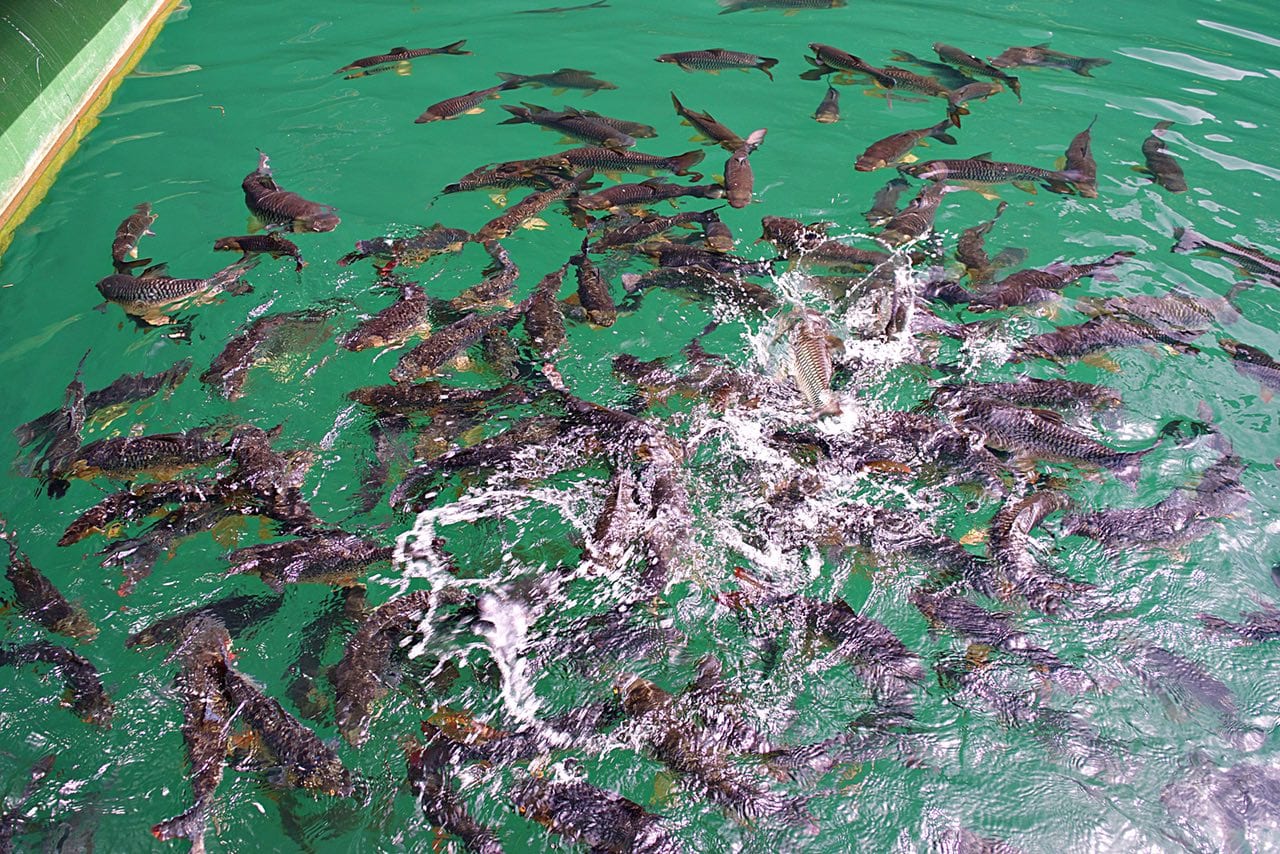
A huge school of fish were living under the dock. Perhaps they were here to recycle food scraps. Perhaps they were here for our entertainment. Note for the guys, don’t help your fish phobic wife by feeding the fish when she’s taking a GoPro movie.
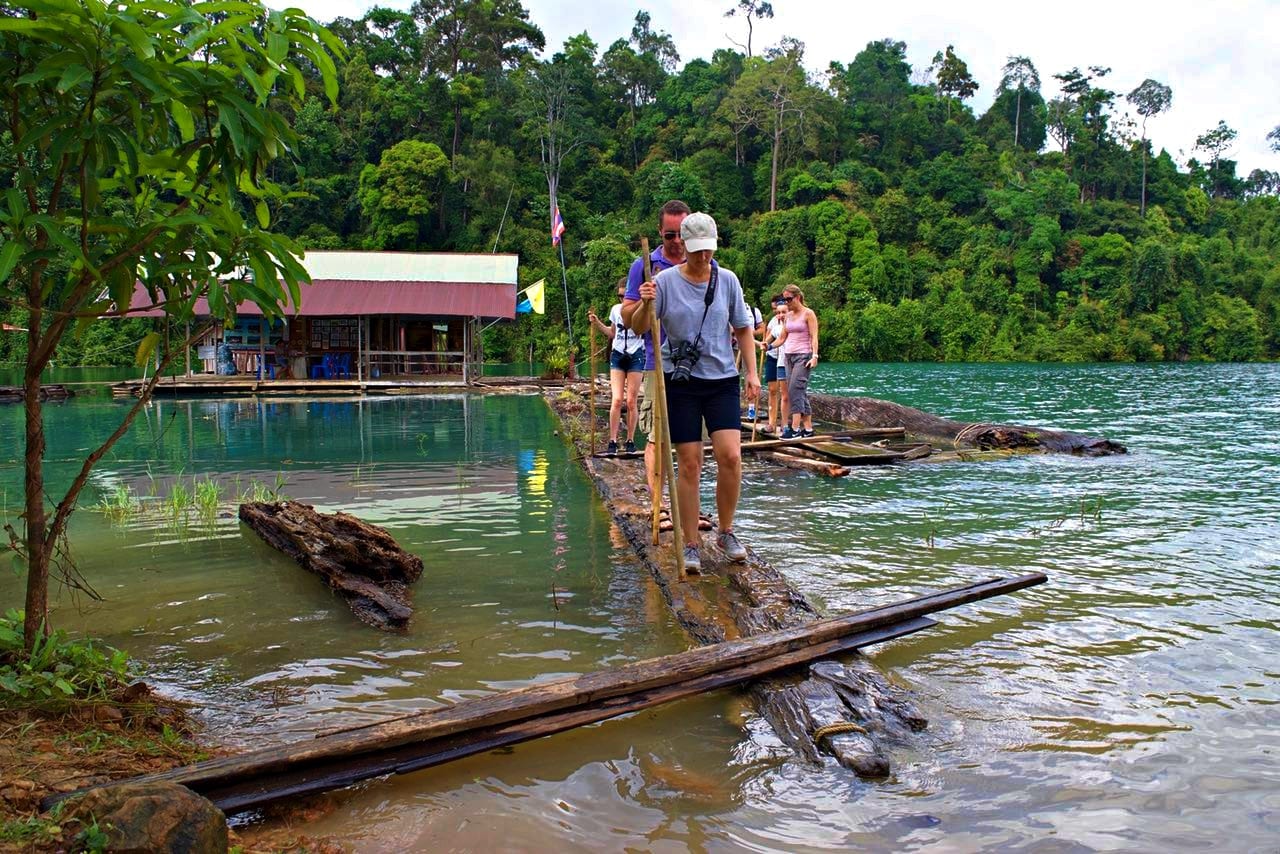
Ed’s afternoon adventure was the cave and jungle trek. The first obstacle was navigating the crazy dock at the ranger station. I am surprised that nobody fell in.
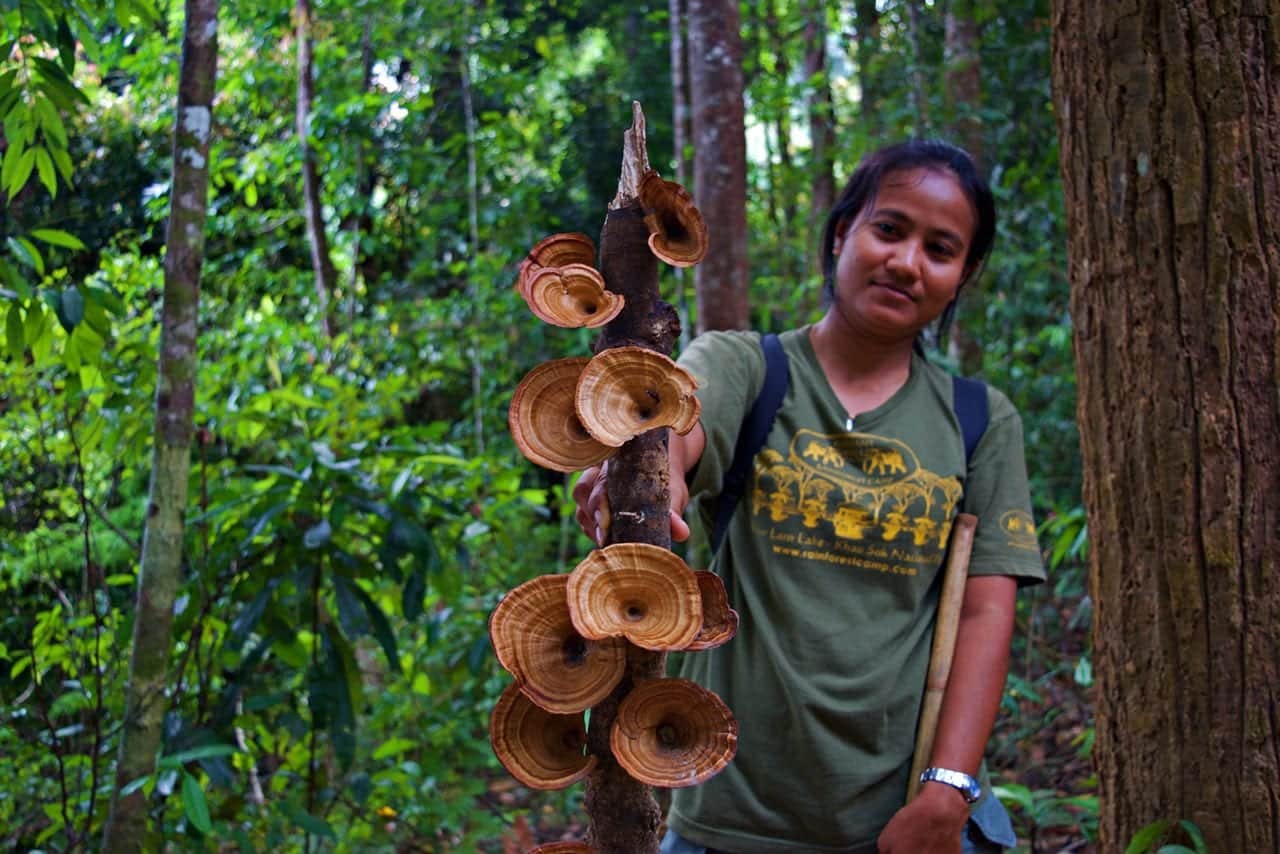
Kong helped guide too. Here she is showing us some cool fungus. Fungus, spiders, flora, fauna there was so much to see and experience in the jungle.
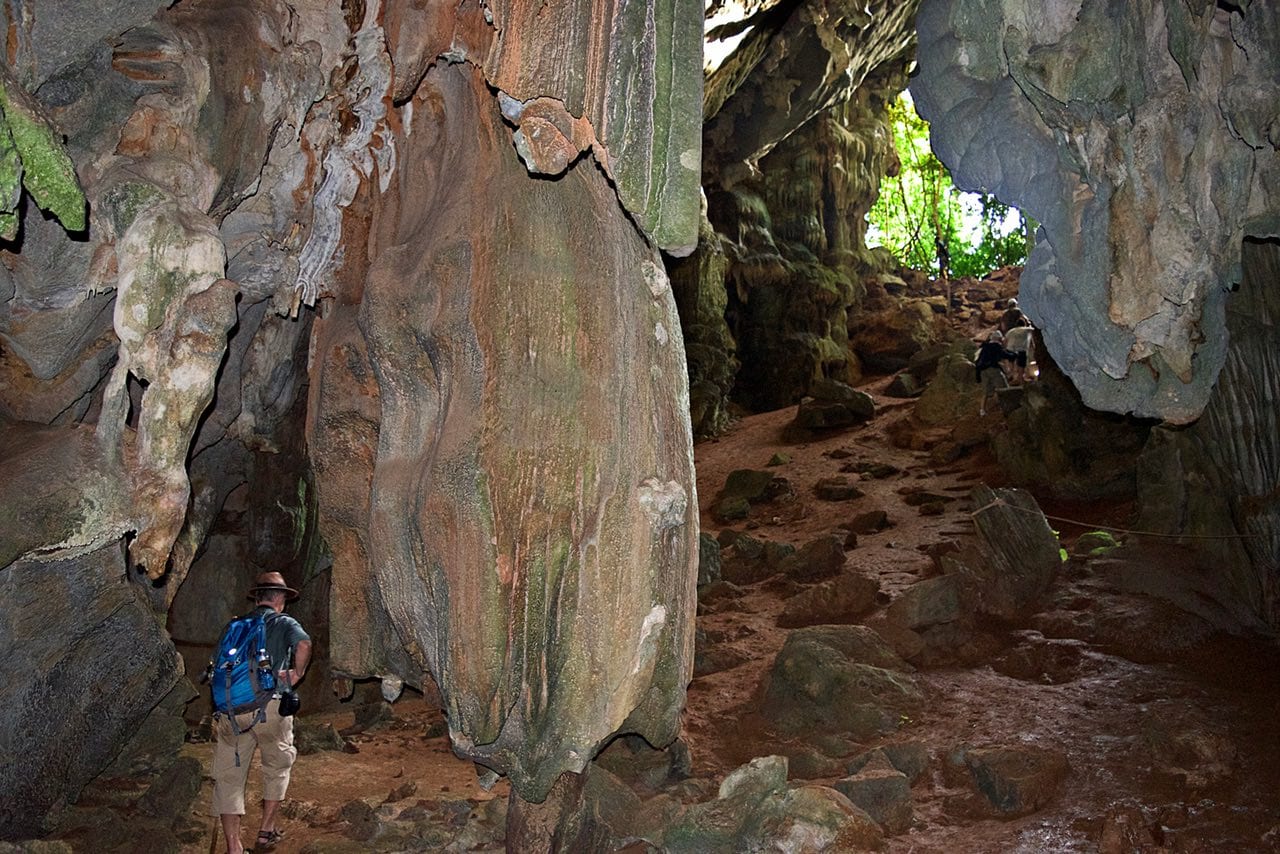
This is the entry room to the cave. It’s big with big formations but the passage ended quickly. Still, I am claiming caving in Thailand baby.
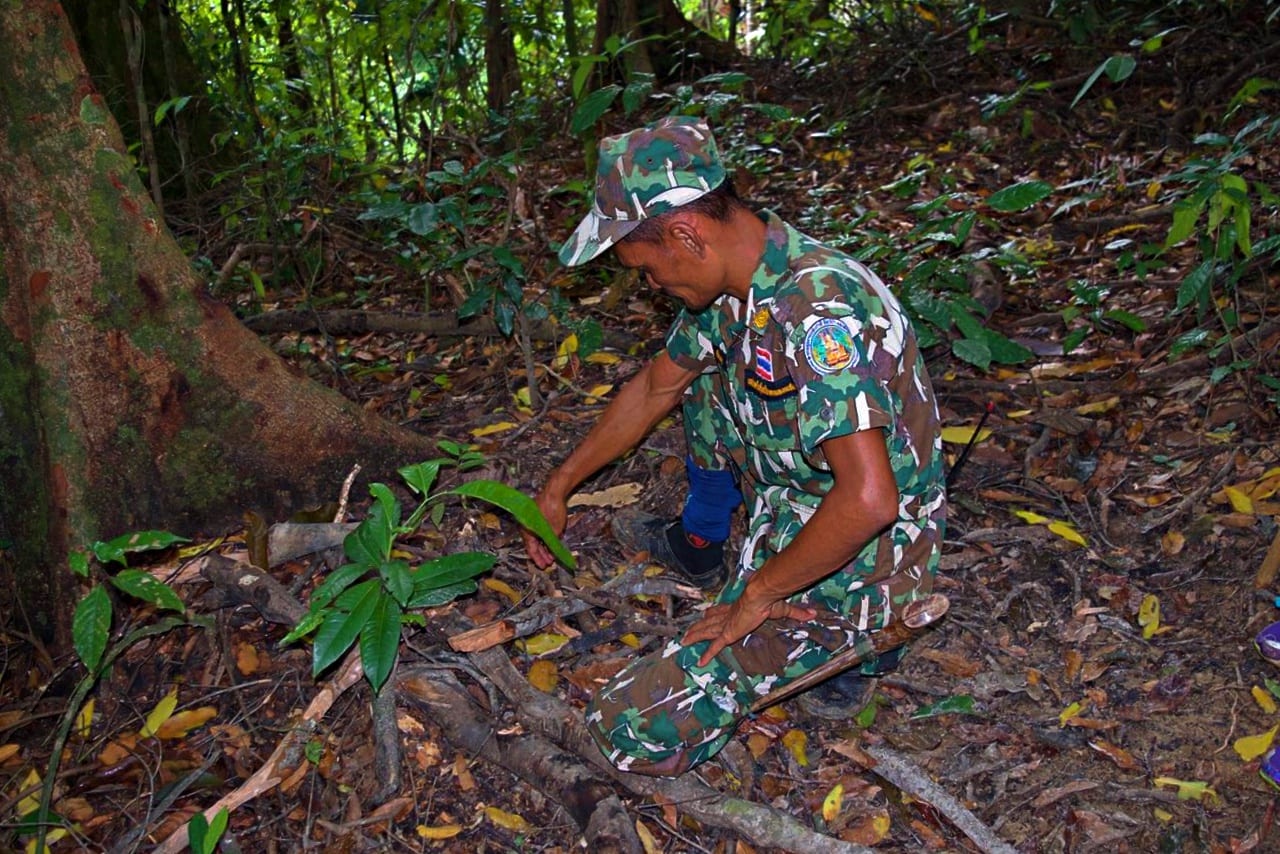
Our guide didn’t speak much English but he knew the secrets of the jungle. He was also an armed government official in charge of keeping out trespassers. Here he is chopping Sandalwood samples for us to smell. Good smells transcends language.
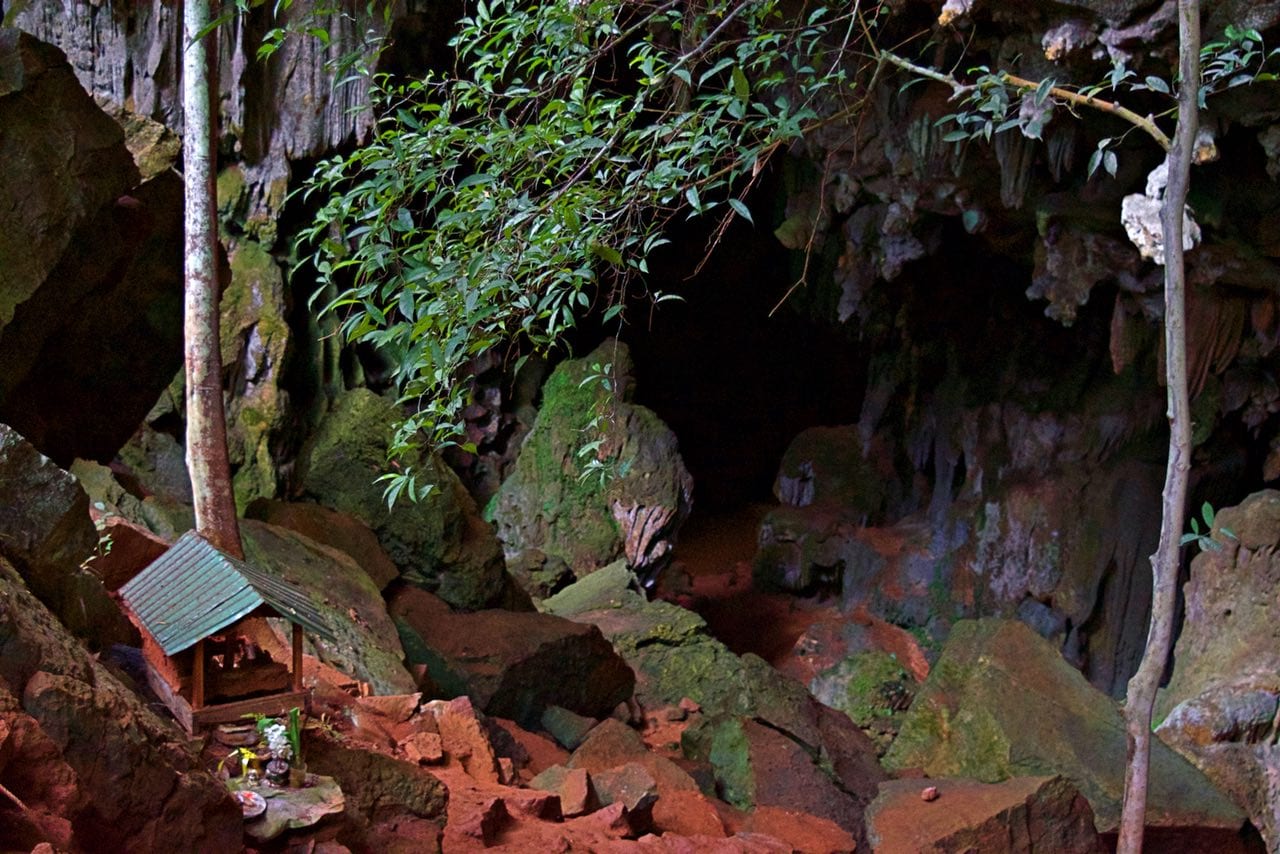
Outside of the cave was a spirit house. Our guide stopped to pay homage to the cave spirits. Not for us and not for show but because he wanted the good luck and blessings he believed they would provide.
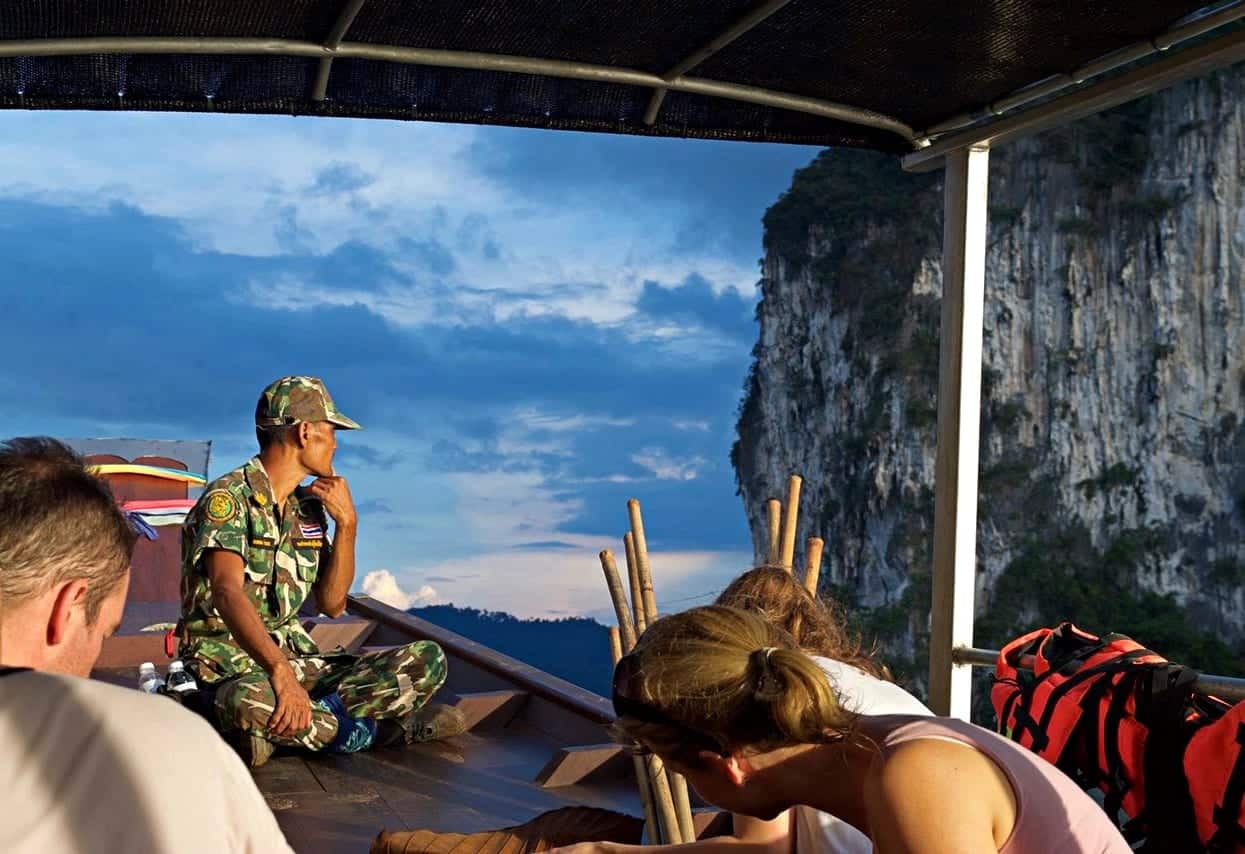
After our hike, we came out on a different trail. Our boats were waiting for us and we got to take the ranger home. I love loop hikes and boat rides.
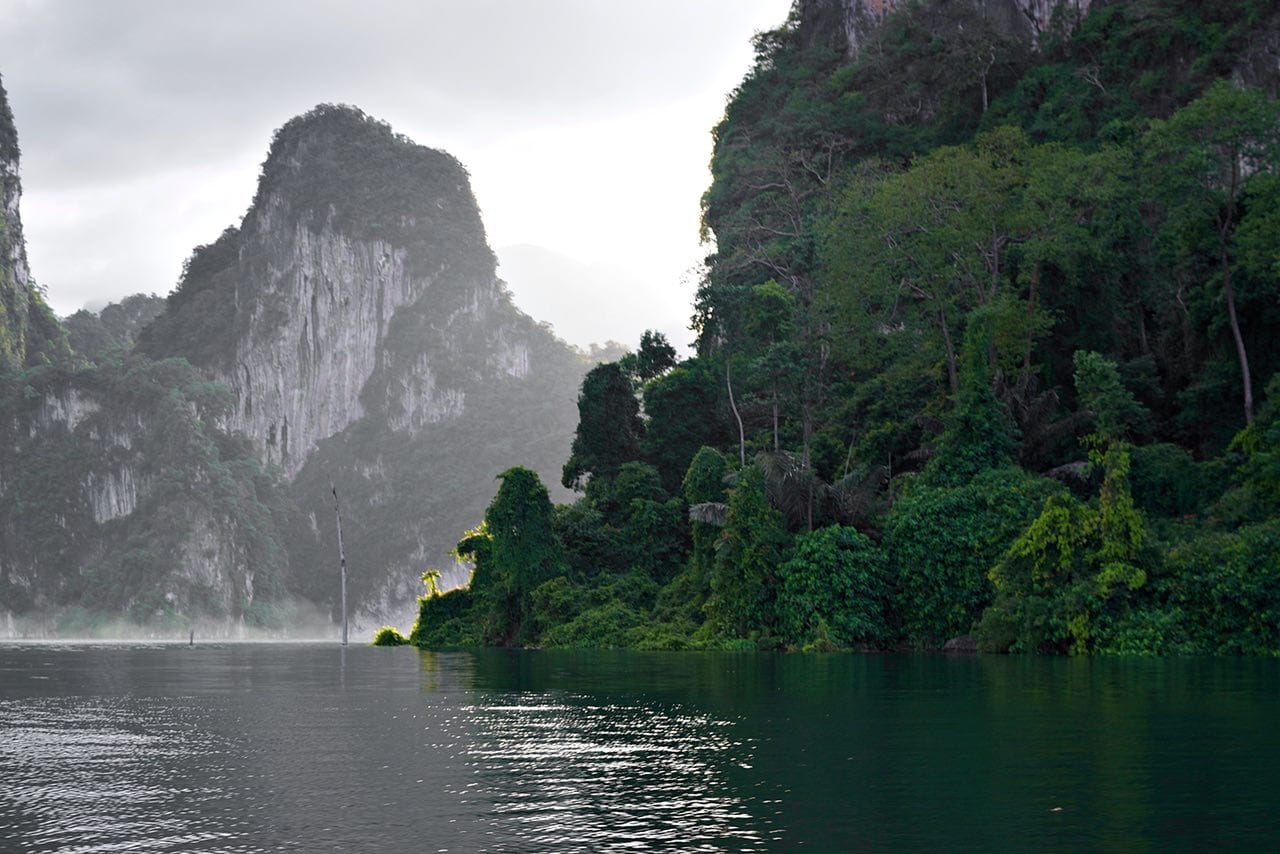
Glamping means sleeping in nature
Something magical happens as night falls in the forest. Jenn experienced this by taking a twilight kayak trip around camp. We met up at the camp’s dock and immediately rushed for the camera. A still had settled on the lake and the water and the glassy surface reflected a burning sunset.
Sunrise was amazing too. Thick clouds obscured the mountains and invigorated the imagination. There are five families of gibbons that live around the camp. Their shrill call and answer rituals pierced through the morning calm. There is no other sound like it. It sounds like a jungle.
We went on to visit a couple of the gibbon families by kayak. Their aerial prowess astounded us. Even mothers carrying little babies would leap from branches and go sailing 30’ through the air before catching another branch mid-air. I remembered how much I always wanted to be a monkey.
Glamping Naturally Supports Ecotourism
It’s easy for glamping to be green. Tents, the camping part, take less space and energy to build than a hotel and you don’t expect air conditioning. The glamorous part means more than nice bath soap and high thread counts. It means that there is enough funding and professionalism to afford proper animal care, ecological initiatives and support for the local community.
It seems like camping attracts people who really love nature and are searching for an authentic experience. Glamping offers all of the above, but with a side of comfort and luxury that can enchant even the most discerning traveler. Just be careful. After a bed like we had, it will be hard to get excited about a sleeping bag and Thermarest. Best of all, if you do it right, like the team at Elephant Hills have, it can also be green. Glamping is a trend in ecotourism we hope continues to grow and we can wholeheartedly endorse.
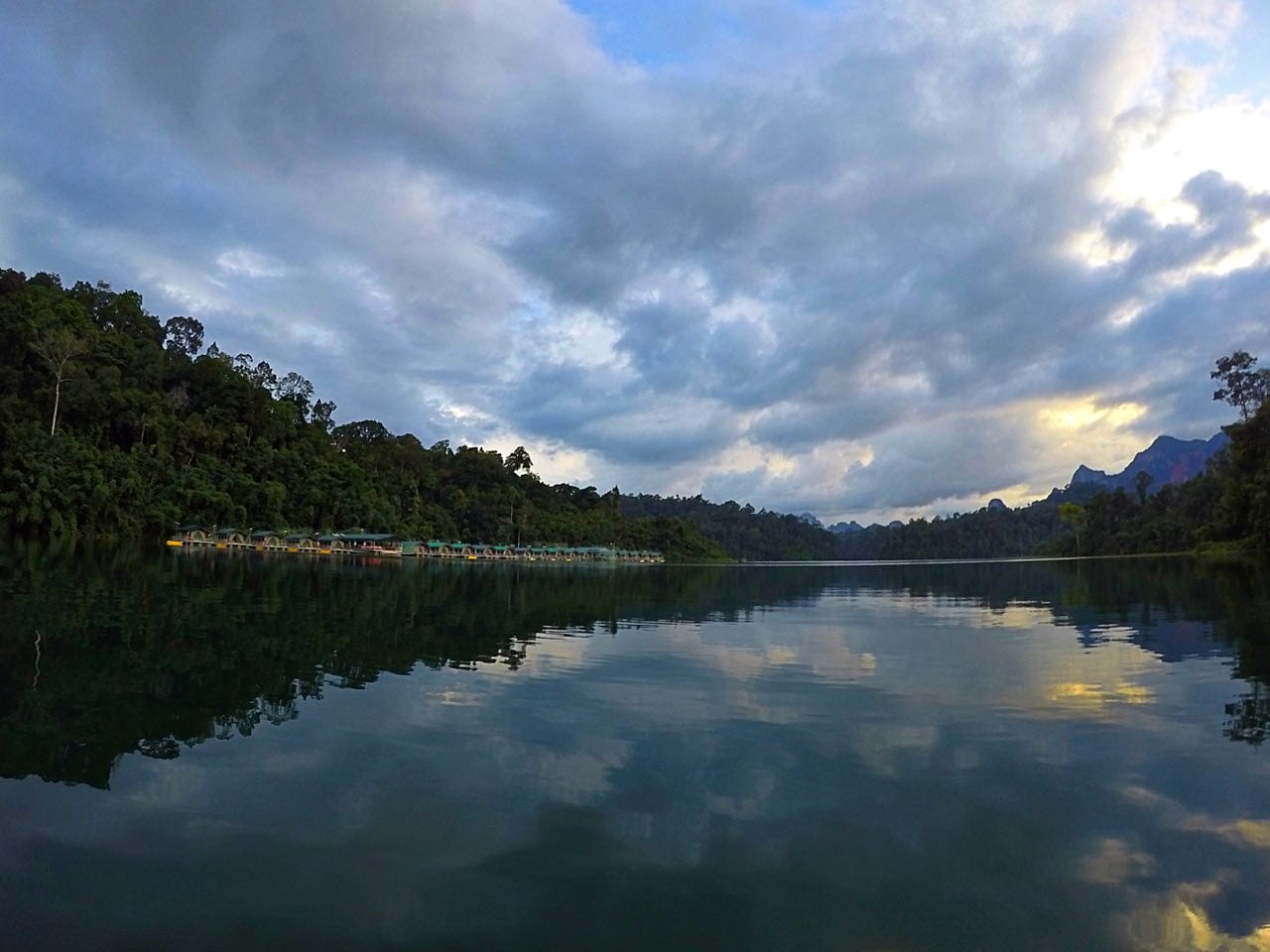
This is the view of camp from across the lake. No need to take a long tail. The kayak worked just fine.
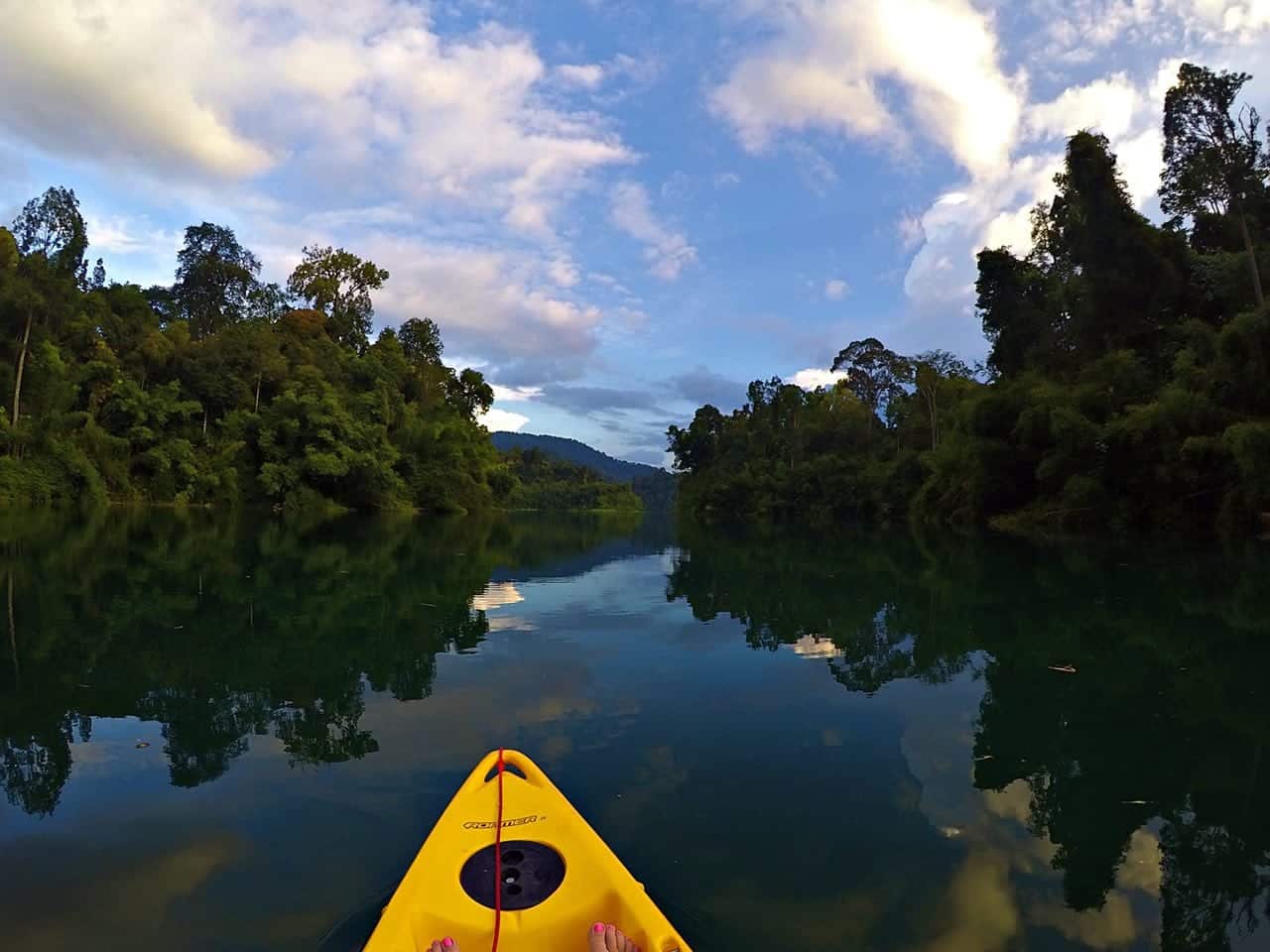
The lake was much narrower at camp. It was about a 10 minute paddle across the lake to a series of small bays. Jenn got to explore two or three of these hidden bays.
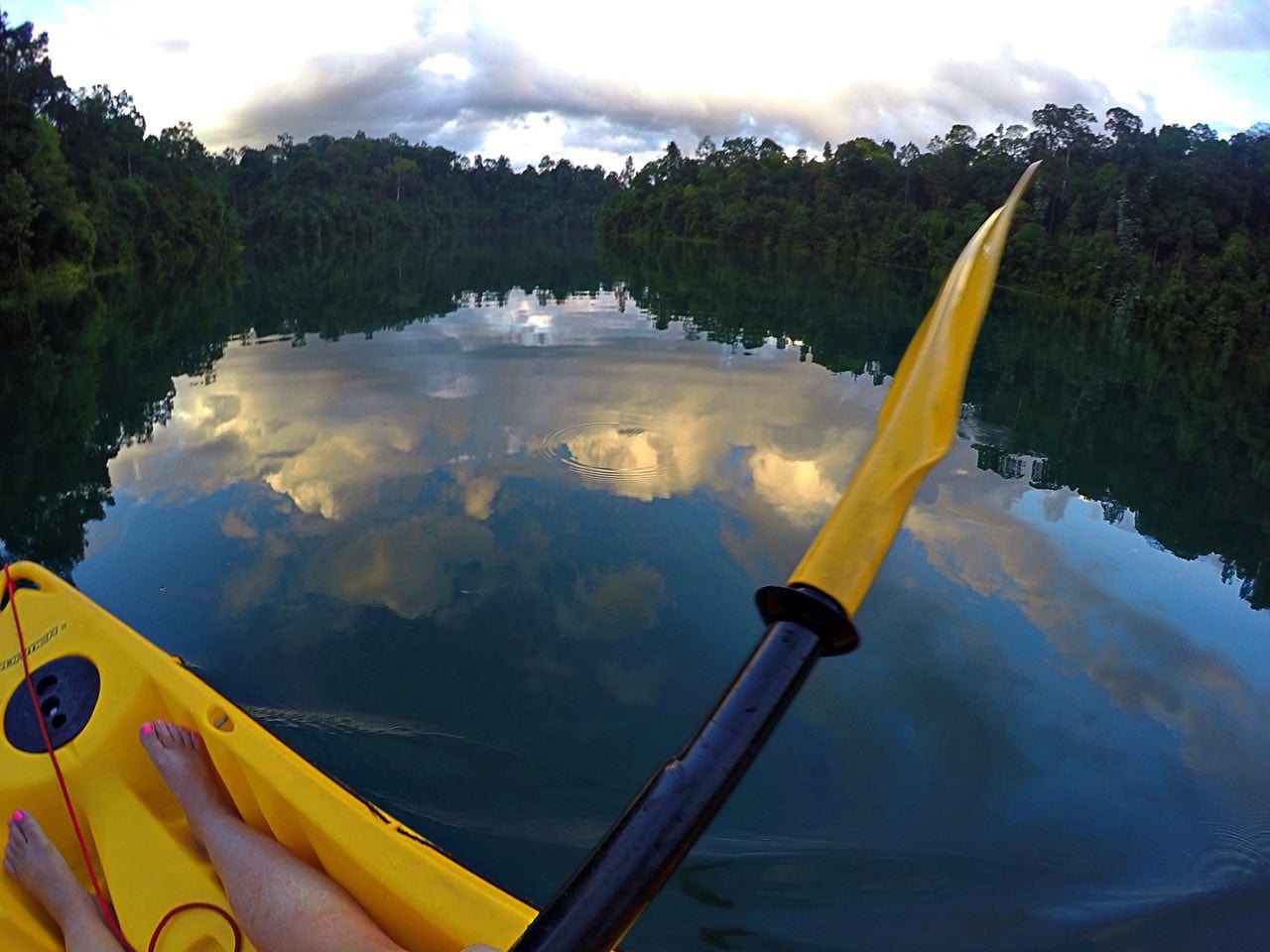
As Ed was caving, Jenn was kayaking. She took the kayak out from in front of the tent and set off across the lake.
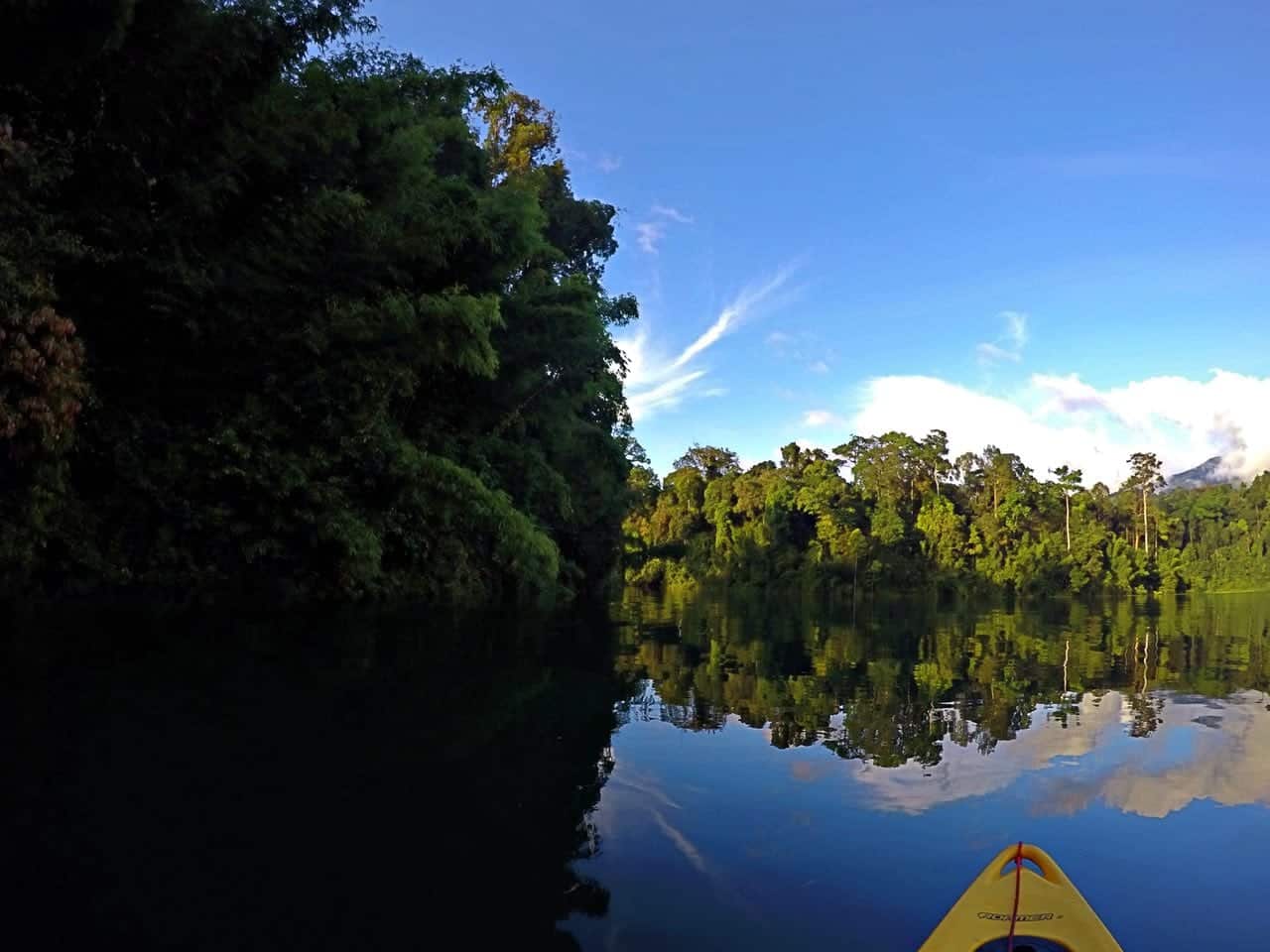
Golden hour was coming for Jenn too. The shadows are getting longer and the reflections more intense.
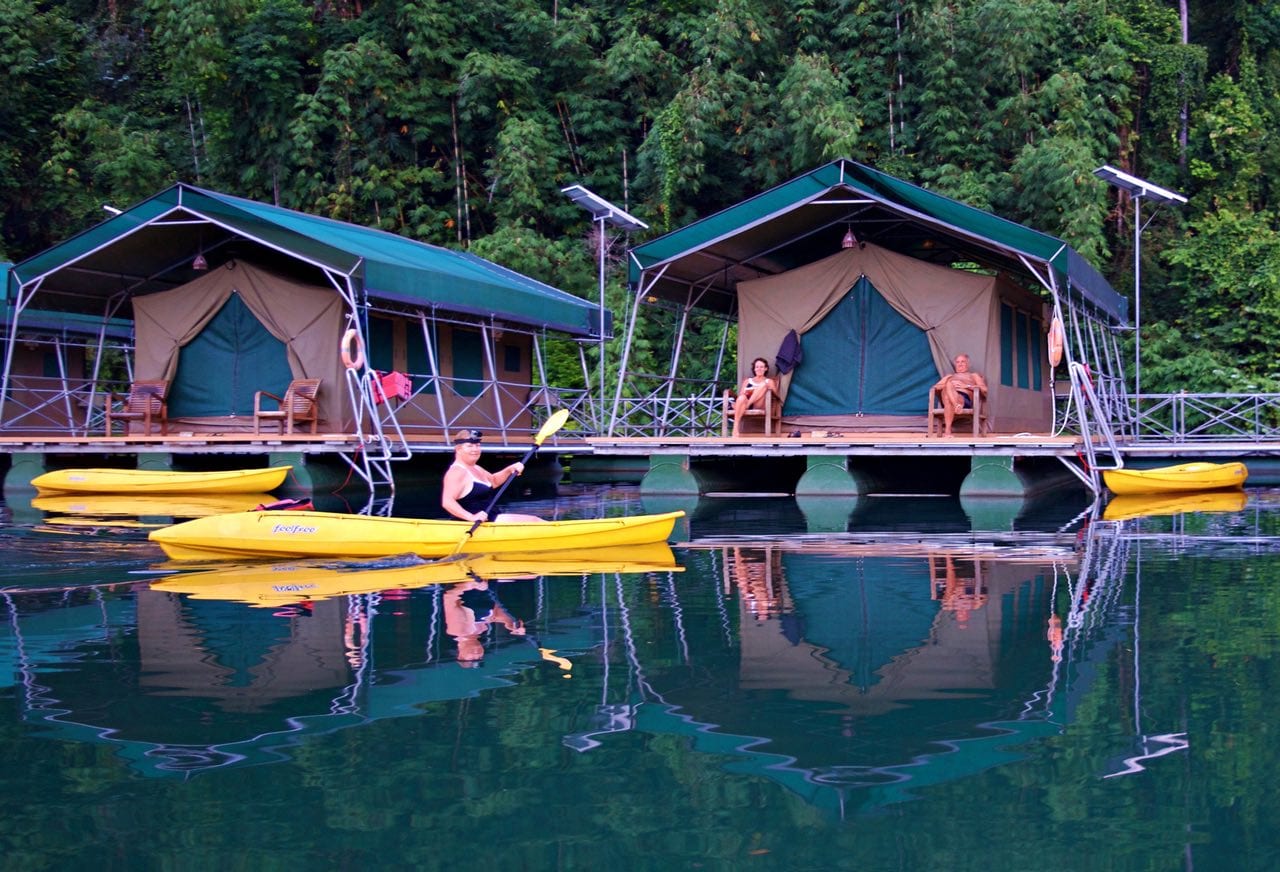
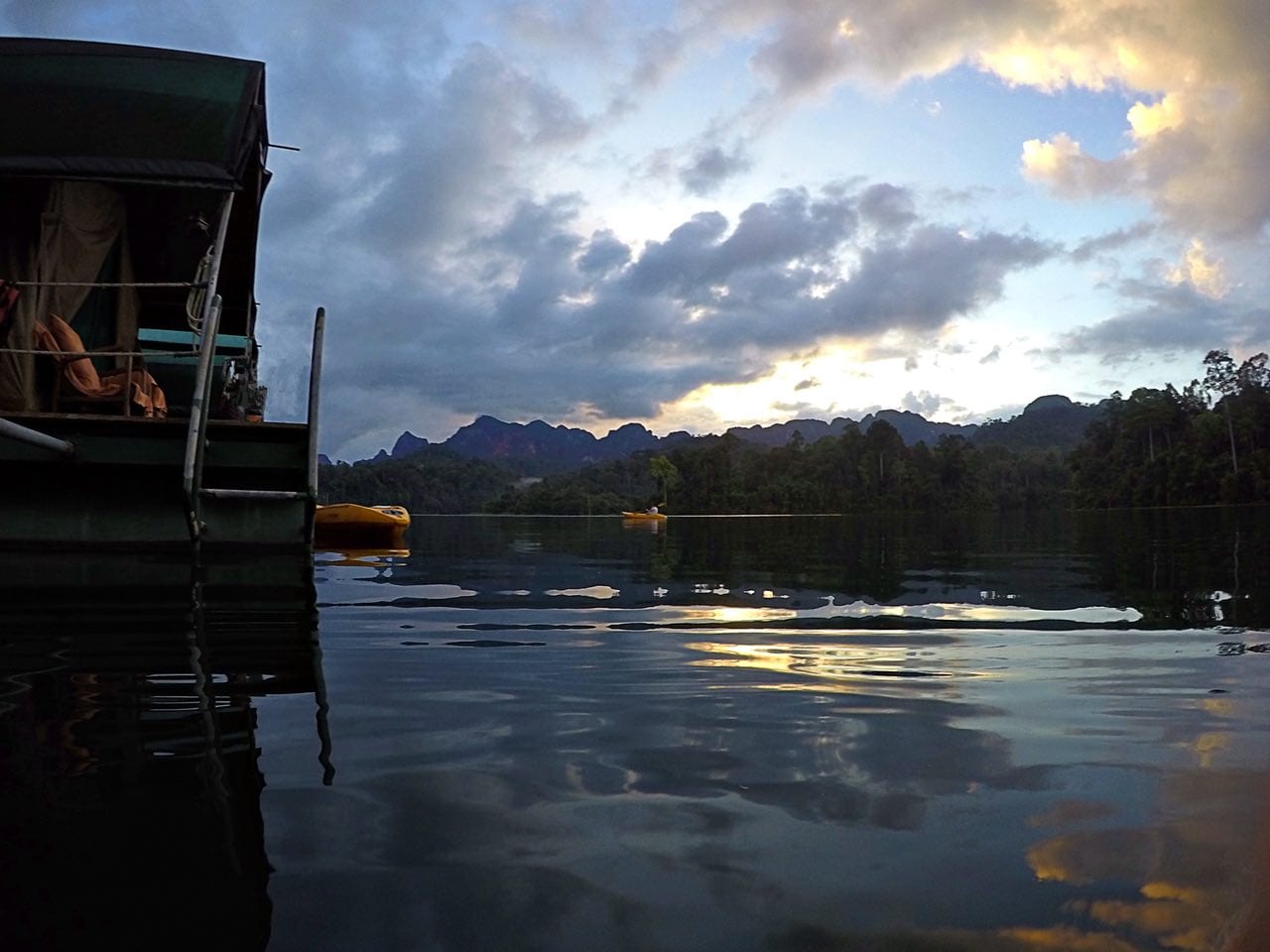
Glamping means sleeping in nature. This is the view from our front porch at the tent. We had to grab a camera and start shooting.
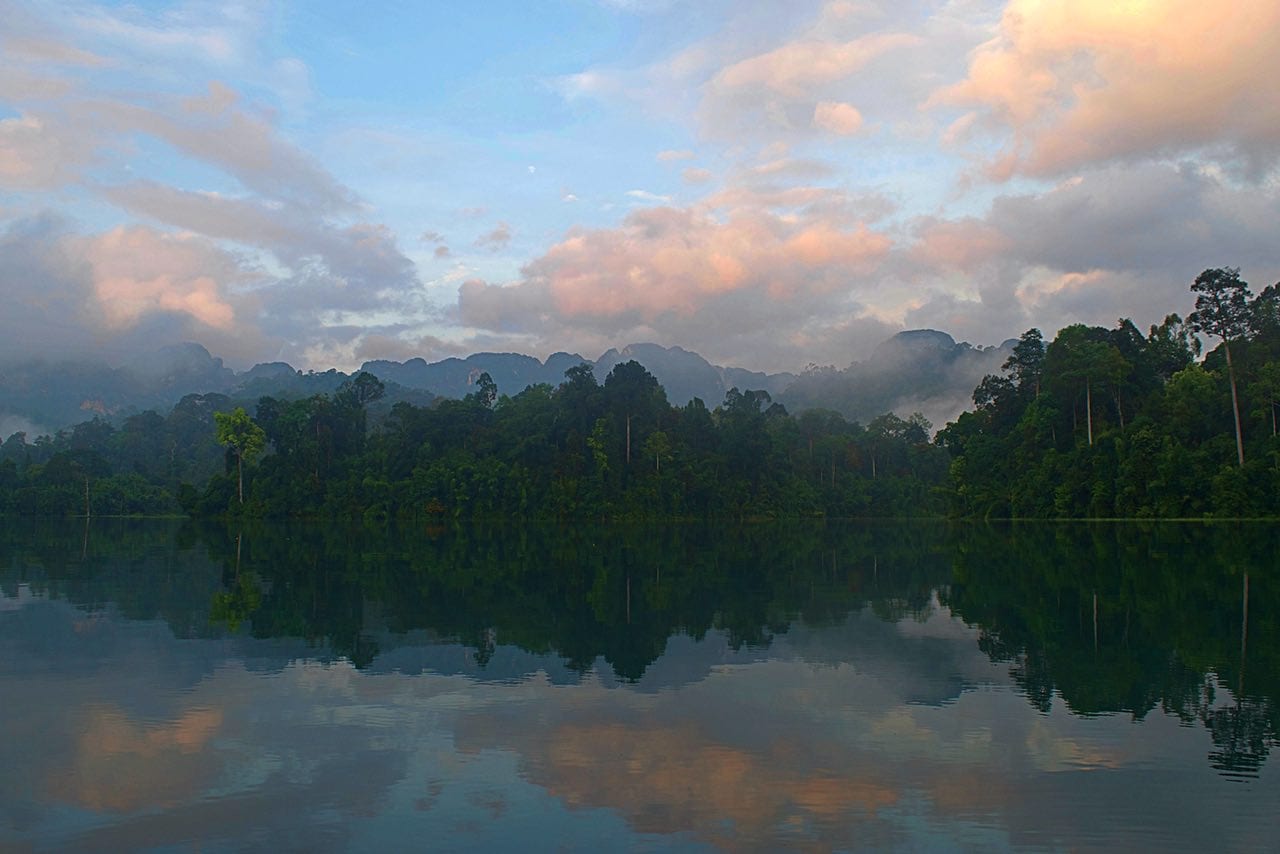
I promised no more sunsets here but how about sunrises? Different pinks. More clouds. Surprising there was a little blue sky poking through.

Last sunset picture, I promise. The reflections on the water was something special. Also, no mosquitoes. I don’t know if it was the carp eating all the larva;or just another benefit of being 100′ from the shore (and undergrowth). Either way, I’ll take it
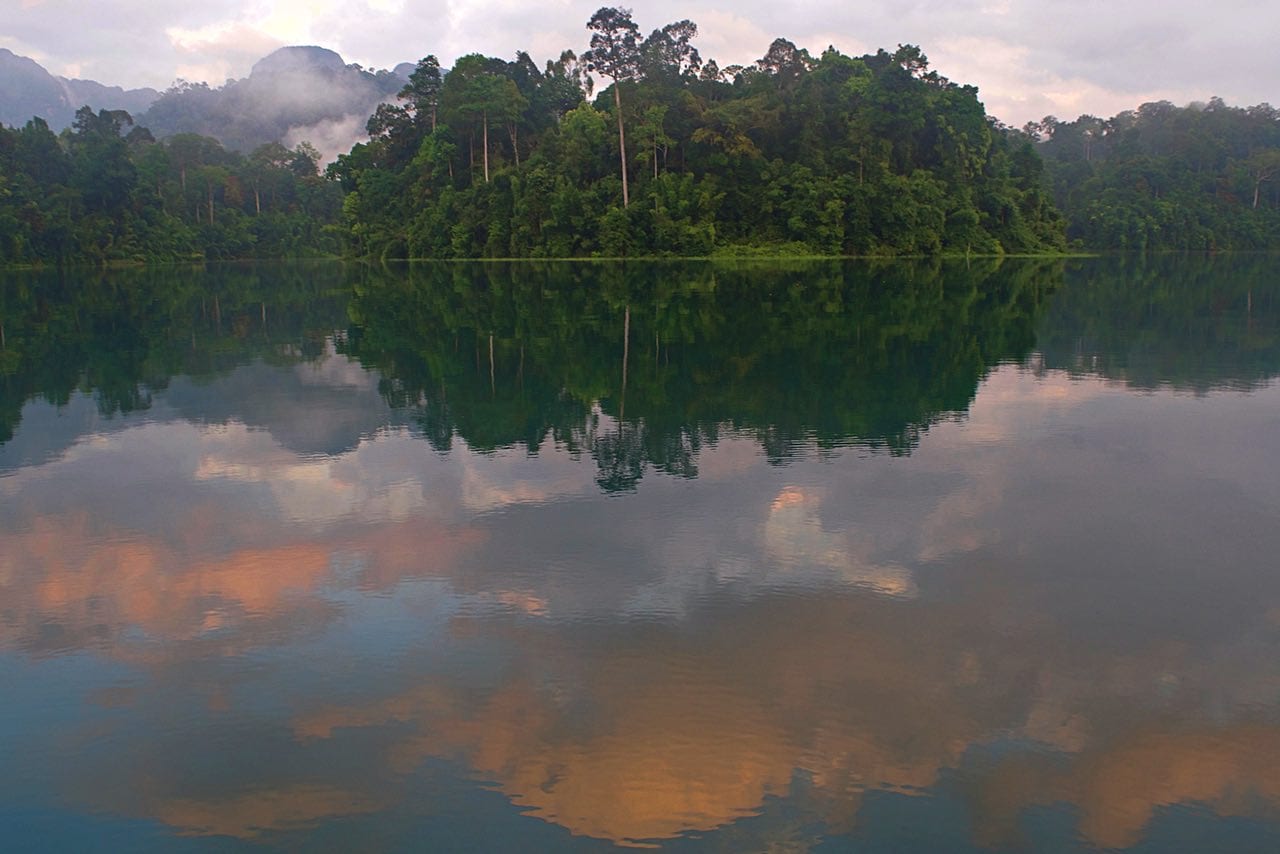
Ok, it’s not just an excuse for more sunrise pictures. This looks decidedly different because we focused on the reflections.
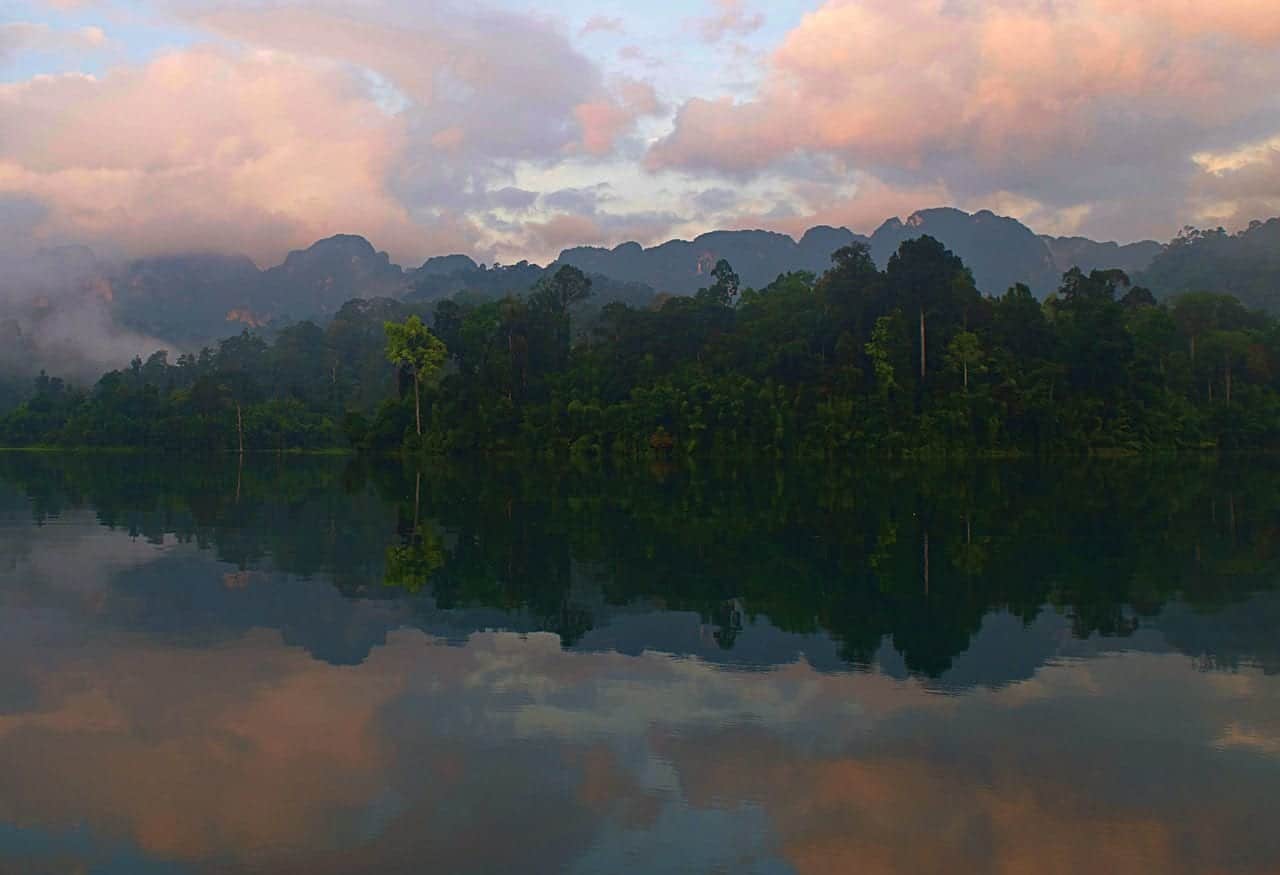
What the Blogosphere is saying:
- Alex in Wanderland says “They [Elephant Hills] designed is an interaction that is far more rewarding and respectful than simply sitting on an elephant’s back.”
- E is for Emma says “After some careful research, I came across a few camps that promote ethical elephant experiences, where the animal’s welfare is considered more important than the tourist’s enjoyment.”
- A Cruising Couple says “An incredible ethical encounter with elephant in Thailand“
- Minority Nomad says “Elephant Hills gives guest an opportunity to not only observe, but to interact with Asian elephants in a natural setting.”
- Wanderlust Us says “We soon got used to the simplicity [of Glamping] of living out here, it was refreshing and made us feel so close to all the nature that was surrounding us.”
- Where to Next says ” we watch a documentary about elephants, followed by a dance recital by some local school kids.” (they included pictures of the dance recital and the cooking demonstration too)
- Have you been to Elephant Hills or another elephant encounter, gone glamping or tried Ecotourism? Let us know in the comments below.

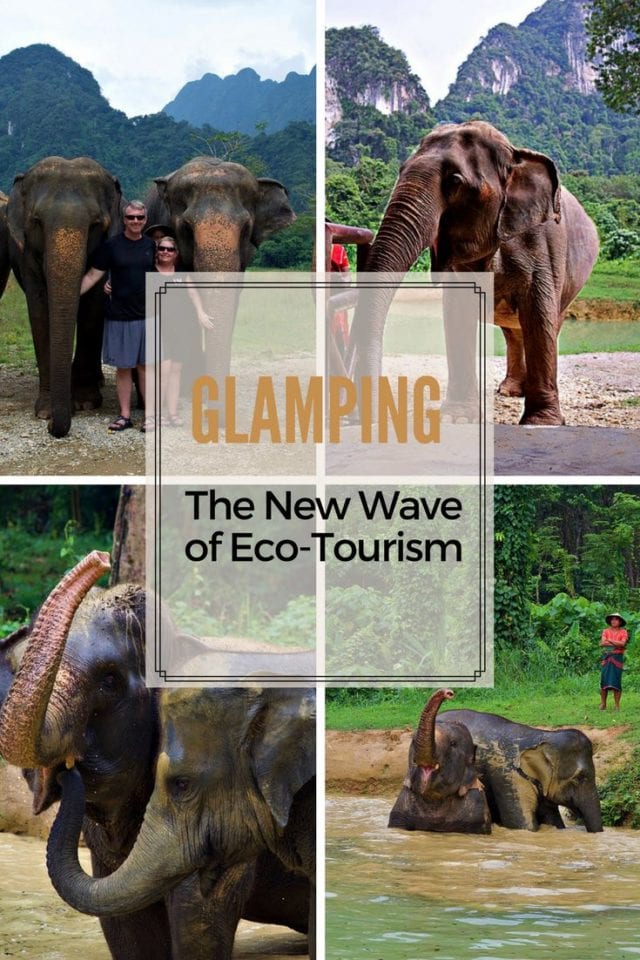
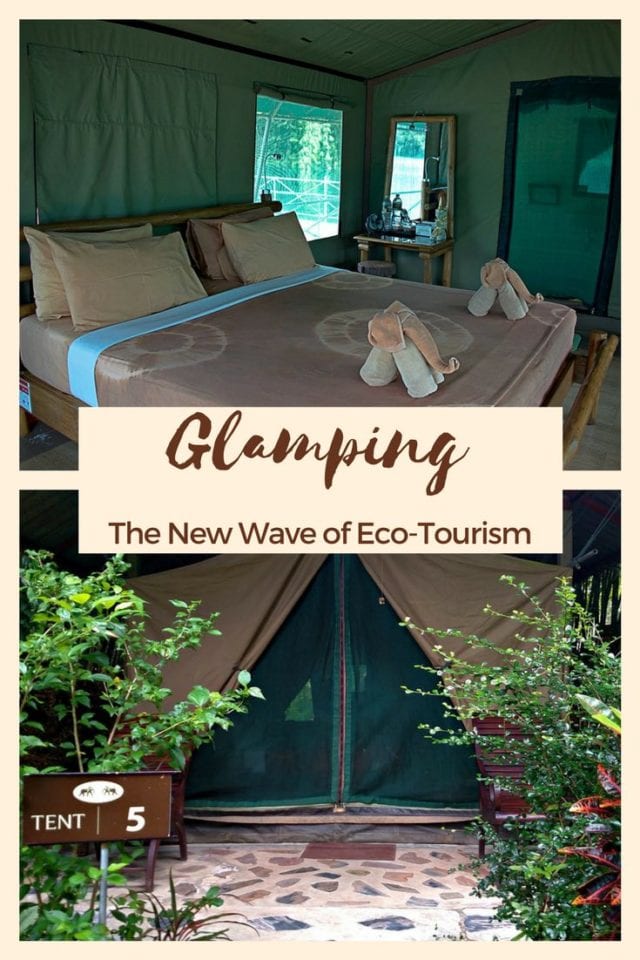
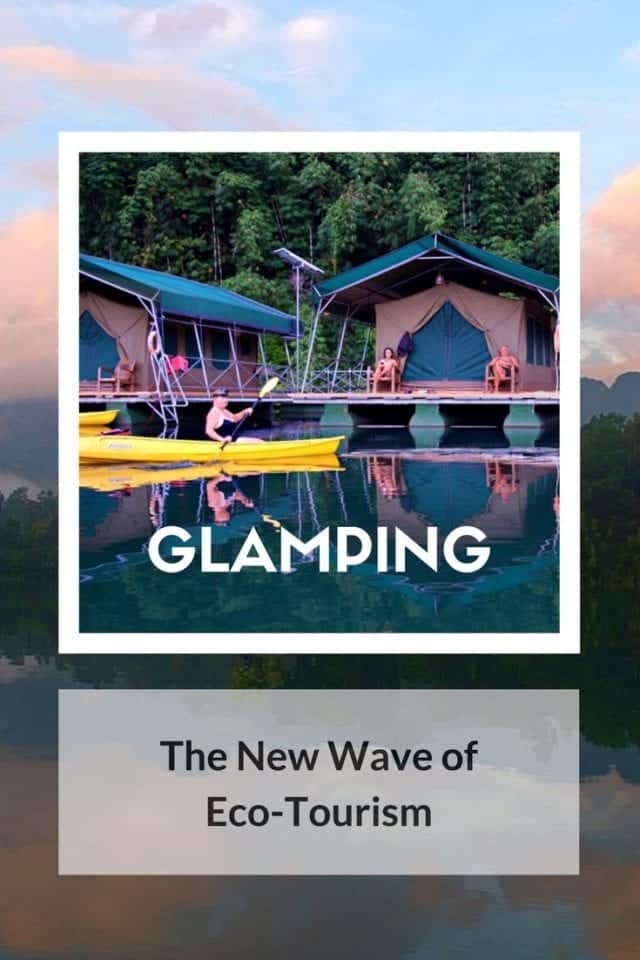
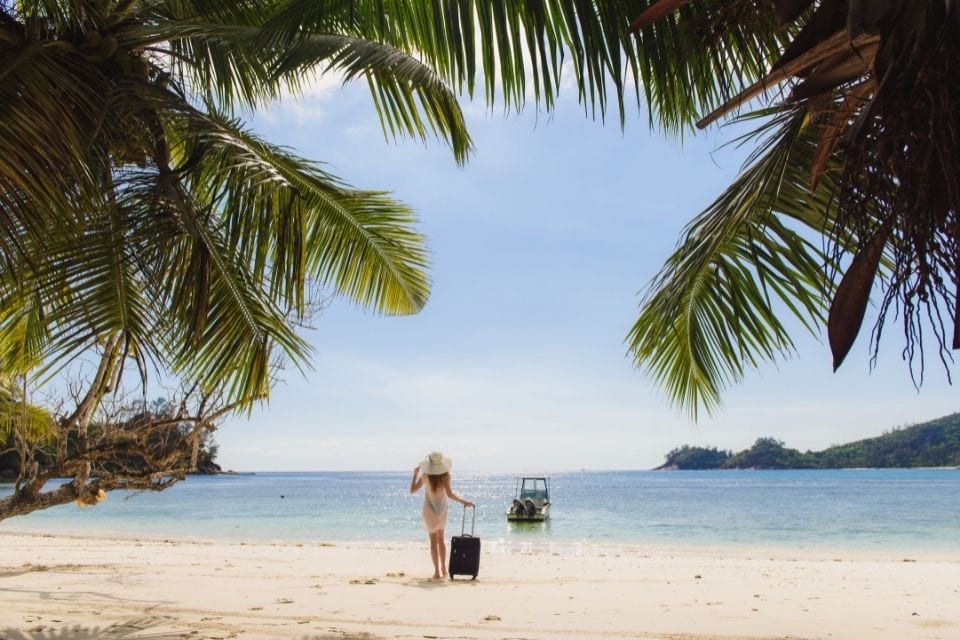
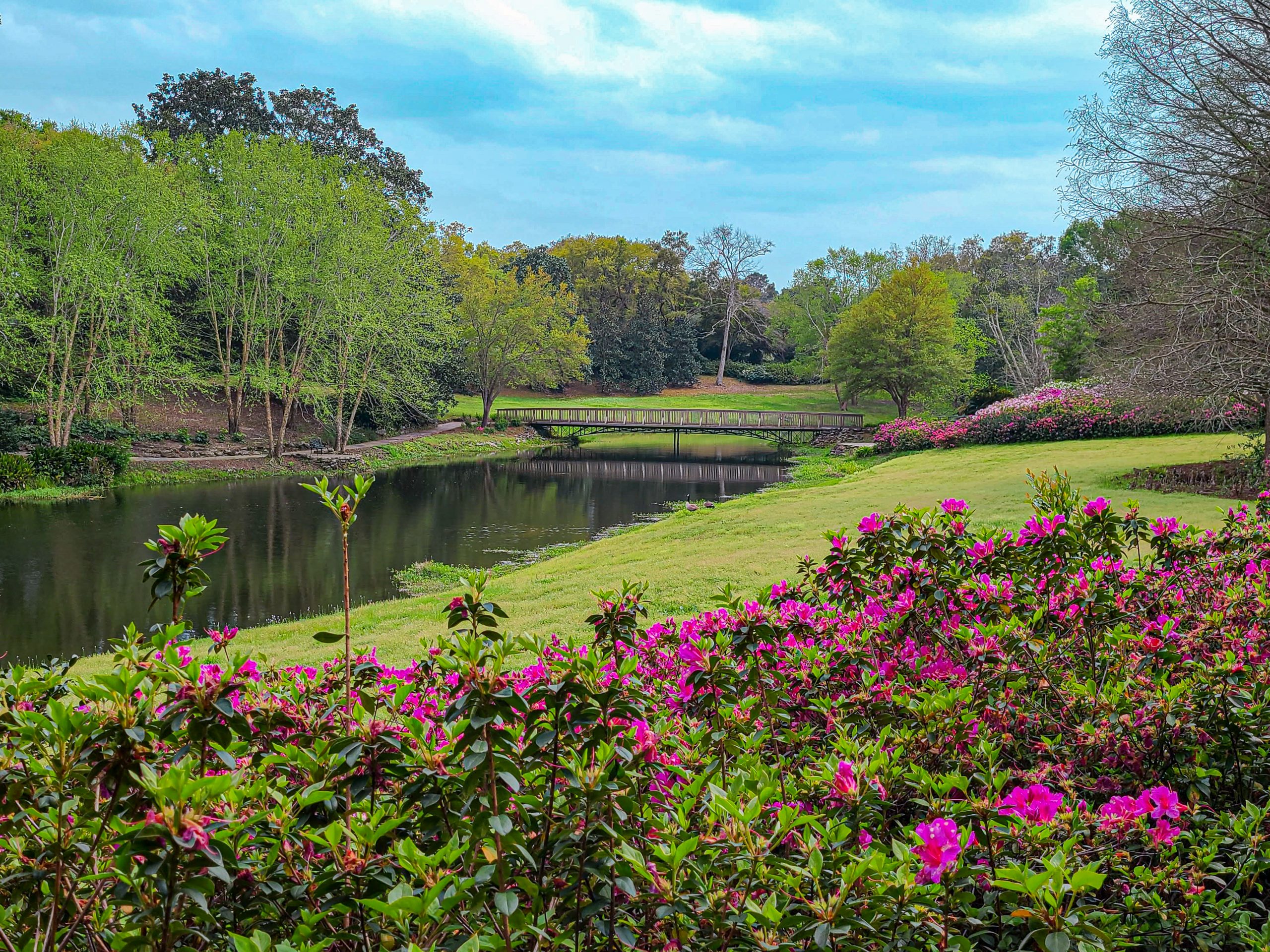

 Hi! We are Jenn and Ed Coleman, and together we are Coleman Concierge. It is our goal to inspire you to get out, expand your world, and to seek adventure, even in your own backyard.
Hi! We are Jenn and Ed Coleman, and together we are Coleman Concierge. It is our goal to inspire you to get out, expand your world, and to seek adventure, even in your own backyard.


